Https Www.scrapbook.com Signup V 04d77f48ab319512672343f7eee866be
Many people think that scrapbooking is a recent phenomenon, but the history of albums, recognizable as something that we'd call a scrapbook today, dates back to not only before the invention of photography – but also to before the origin of the word "scrapbook" itself.
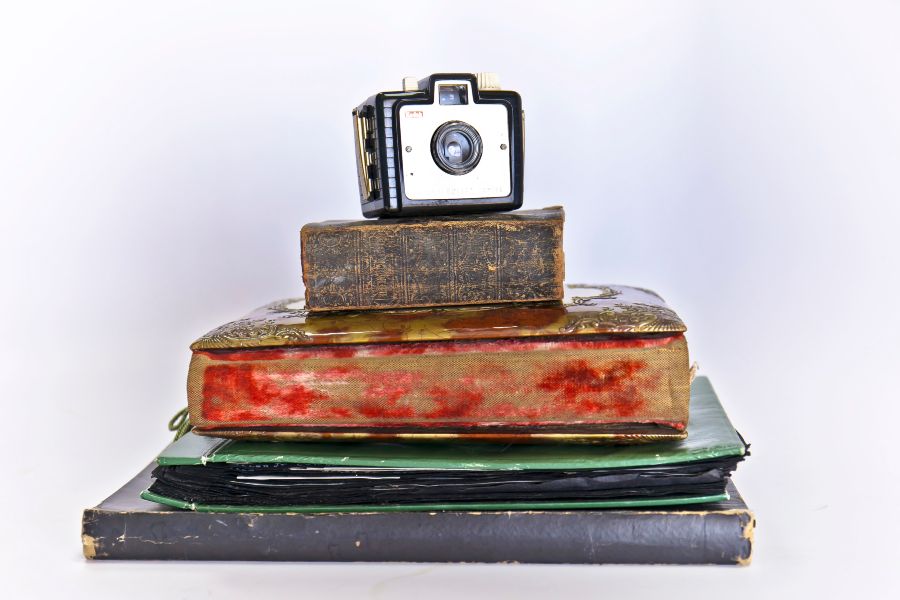
Scrapbooking is rooted in the history of printed images and also in the long history of personal storytelling. It is from the merging of these two progressions that we get the modern scrapbook in all of its current forms.
Early Diaries and Journals
Where did scrapbooking originate? We have to go way, way back to early diaries and journals. As early as the Middle Ages, it was quite common for well-educated people to keep personal diaries or journals that recorded their thoughts on their life's activities and events around them. Perhaps the earliest known surviving journal is known today as Journal d'un bourgeois de Paris, The Diary of a Bourgeois from Paris. Written in Paris between 1409 and 1449 by an anonymous French priest, the journal's personal accounts of 15th-century life in the French capital is a treasure trove for historians.
Commonplace Books
During the Renaissance period (the 14th to 17th centuries), it became popular for noble and educated Europeans to keep what were called "commonplace books". As the printing press wasn't invented until the later half of that period, these books had a closer resemblance to, what today we would call "bullet journals" – a bound journal of blank pages that contains assemblages of notes from various sources on various topics, rather than a book that is filled with glued-in paper items.
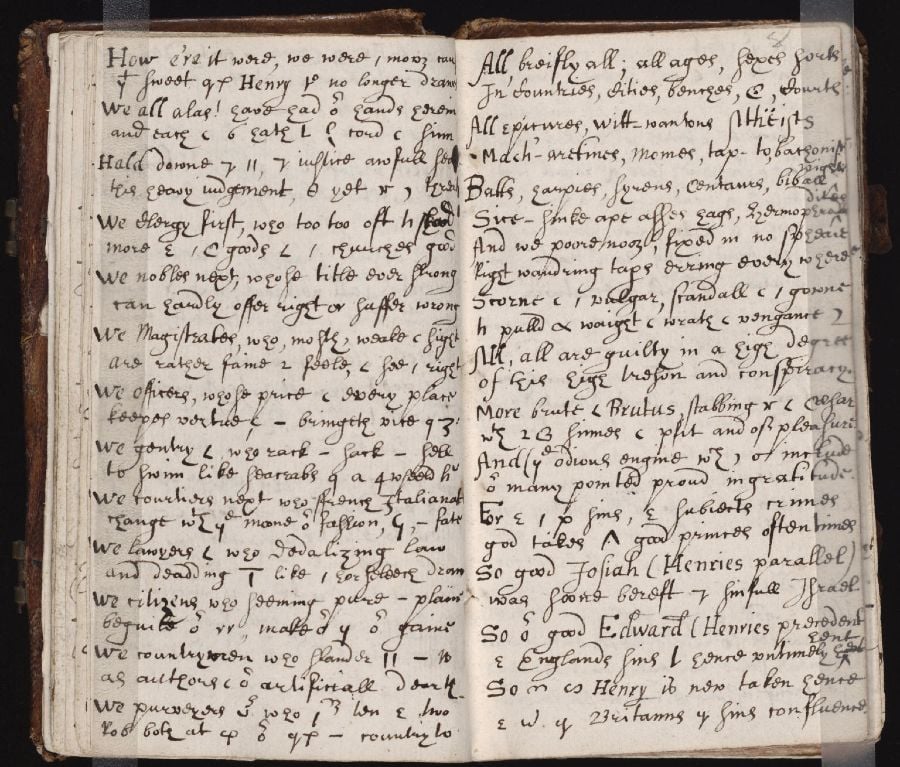
Photo of Commonplace Book featuring English Poetry (CC 2.0). The owner of this original commonplace book is unknown.
The perfection of the printing press and moveable type by Johannes Gutenberg, in the 1440s, allowed many more people to have contact with printed material. Previously, books had been laboriously hand copied by scribes, so only the wealthiest people in society could afford them, and only in small numbers. After the invention of the printing press, books and printed material became more and more widely available, making mass amounts of information available too! The Renaissance was, in a sense, the first era of information overload.
The commonplace book became a way to prioritize and organize this newfound flow of information. Students and scholars would copy down key passages from materials studied in libraries into their commonplace books. Scientists, writers, and philosophers used their commonplace books to record inspiration and the progress of their work. Ladies would record their favorite religious passages, recipes, and quotes from the books that they read.
Commonplace books were not personal diaries or even a way of recording the owner's inner thoughts, but rather a way of collecting and organizing a variety of information and material that came to the person from a variety of sources – a gathering of informational "scraps."
Today there are how-to guides for scrapbooking. Back then there were how-to guides for commonplace books, written by Renaissance scholars to teach those who wanted to learn the skill. As early as 1512, scholar Desiderius Erasmus penned a guide to commonplace book note taking titled De Copia. Later, in 1685, Philosopher John Locke wrote a treatise on commonplace note taking that created an alphabetical indexing system that would not be out of place in today's bullet journals.
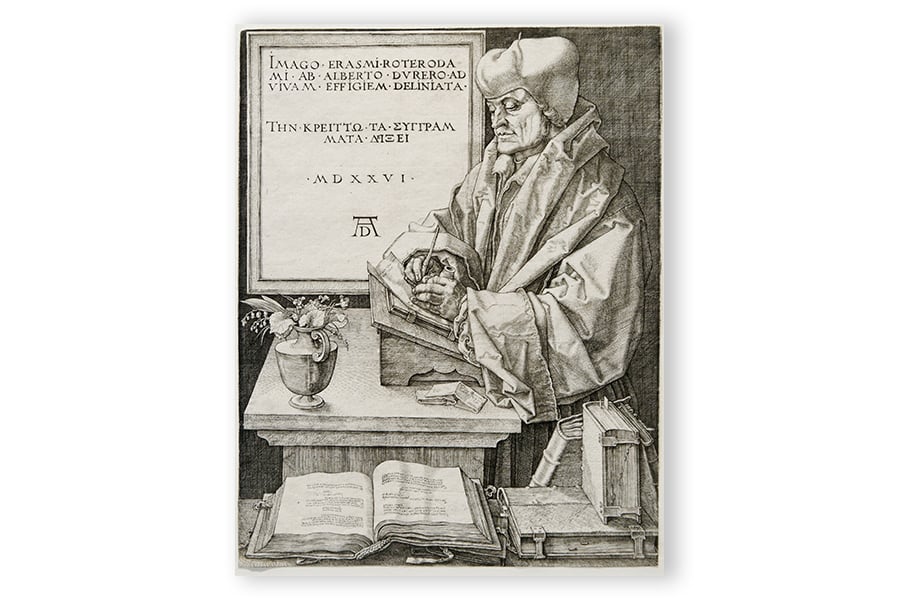
Portrait of Desiderius Erasmus by Albrecht Dürer, 1526, shows Erasmus writing.
Some commonplace books by famous Renaissance (and post-Renaissance) scholars are preserved in archives, giving the academics of today a window into a variety of great minds like John Milton, Sir Francis Bacon, Ludwig von Beethoven, Charles Darwin, and more. Two of Thomas Jefferson's commonplace books are in the archives of the Library of Congress! One of his books contains legal notes from when he was a studying law. The other book is literary themed, containing quotes in English, French, and Greek, from many books he read over a long period of years – a commonplace book version of a modern quote mini-album!
Bibles as Scrapbook Albums
Following the invention of the printing press in the mid-1400s, as well as the proliferation of bibles, many families recorded their family histories on the blank pages at the front of their family bibles. The annotations included the full names, dates of birth, marriage records, and dates of death. According to John Jeffcoat of The Bible Museum, this practice began shortly following the invention of the printing press and grew in popularity through the centuries that followed.
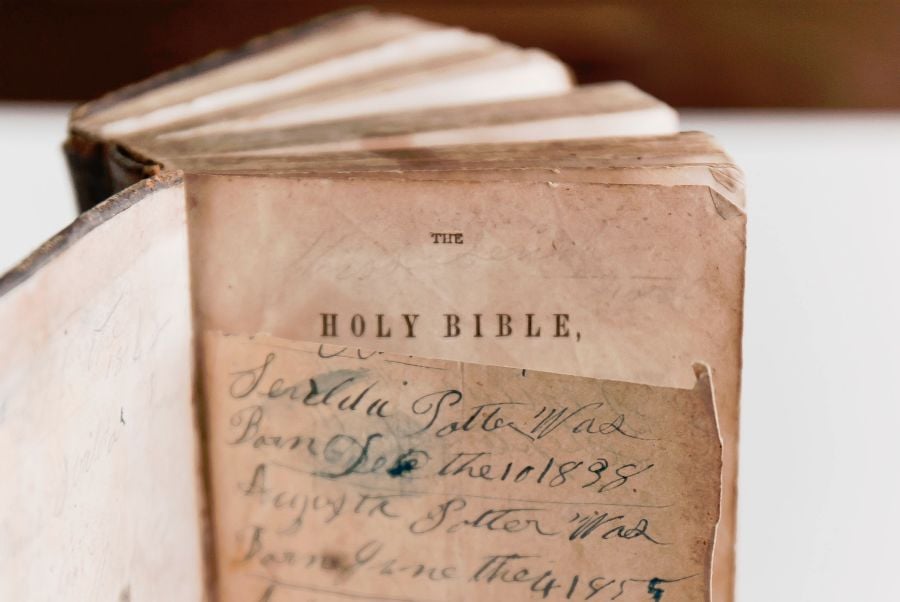
A bible from the mid-1800s. Blank pages at the front of the bible were used to document family births and deaths.
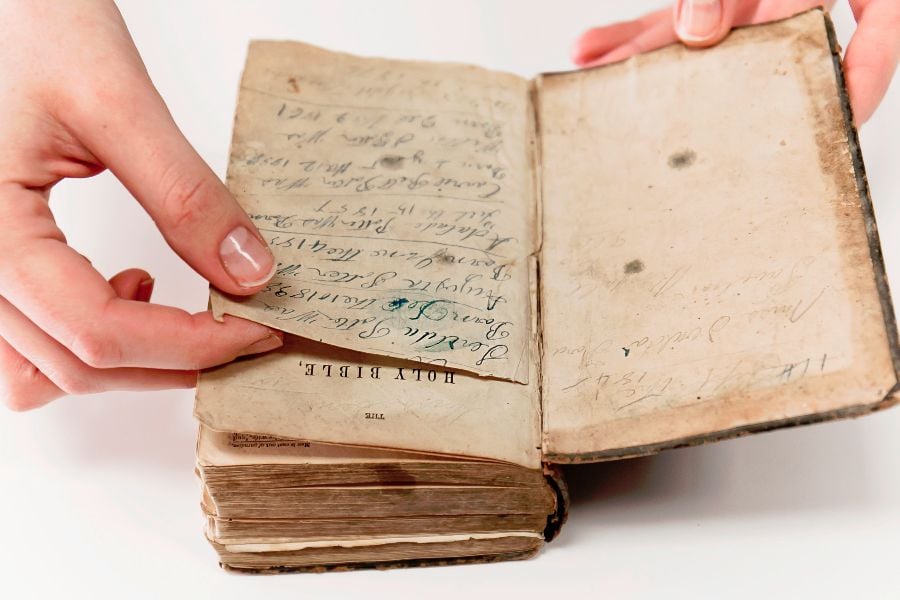
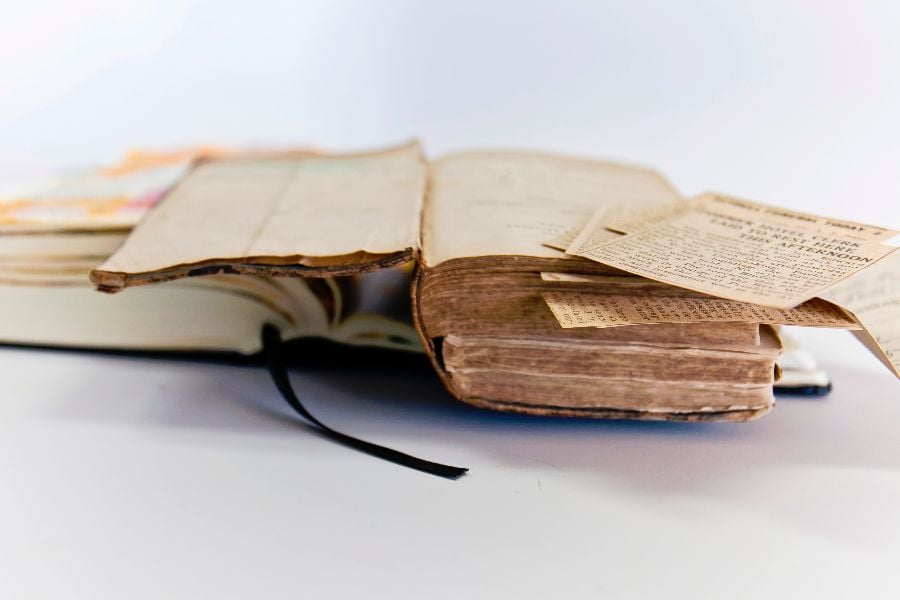
This 1800s bible was used over the course of several decades to store important family documents including obituaries, birth and wedding announcements. The documents were tucked in between the pages and in the back for safe-keeping.
These family records in bibles from the 1400s are some of the earliest forms of personal family history-keeping and represent some of the first attempts to capture family history in books. Family bibles have also been instrumental in mapping genealogical roots for millions of people who lived during these centuries.
By the mid-1800s many bible publishers started included pre-printed pages with places for birth, wedding and death dates to facilitate family record-keeping. It was also not uncommon during this time for families to store important newspaper clippings or documents between the pages of the family's bible - essentially using their bibles as scrapbooks. These "scraps" ranged from birth announcements to obituaries, and other items with sentimental significance to the family. By the late 1800s some bibles even included open portrait slots where the family could insert and store photographs of family members. These antique bibles were literally used as family scrapbooks.
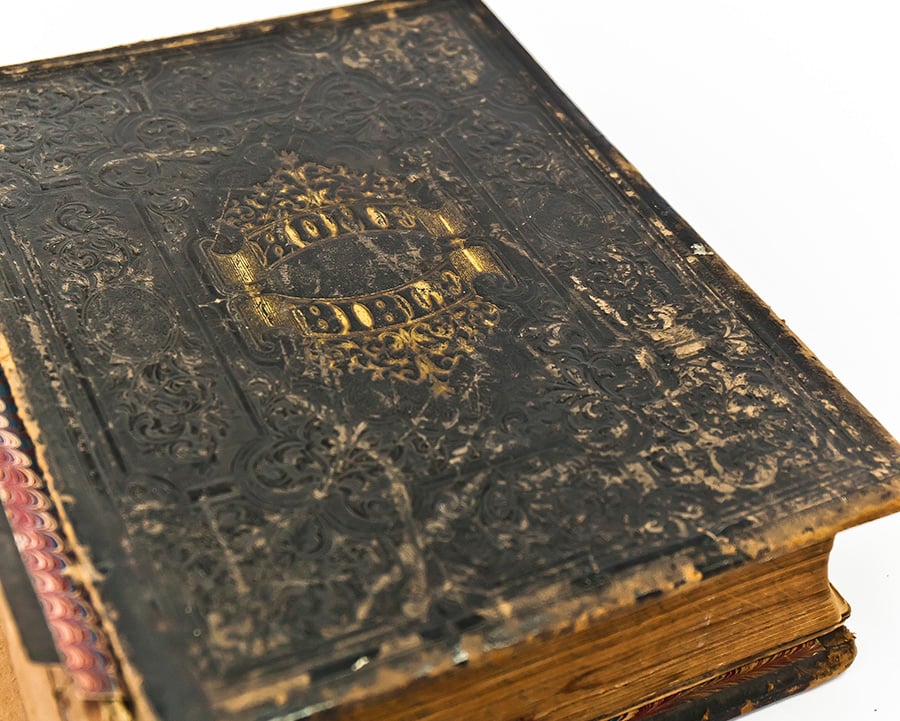
This 1870s bible, owned by the Baldwin family, was used as a family scrapbook. It included newspaper clippings, birth, death and marriage records, a handmade cloth bookmark, family photographs and even a lock of hair.
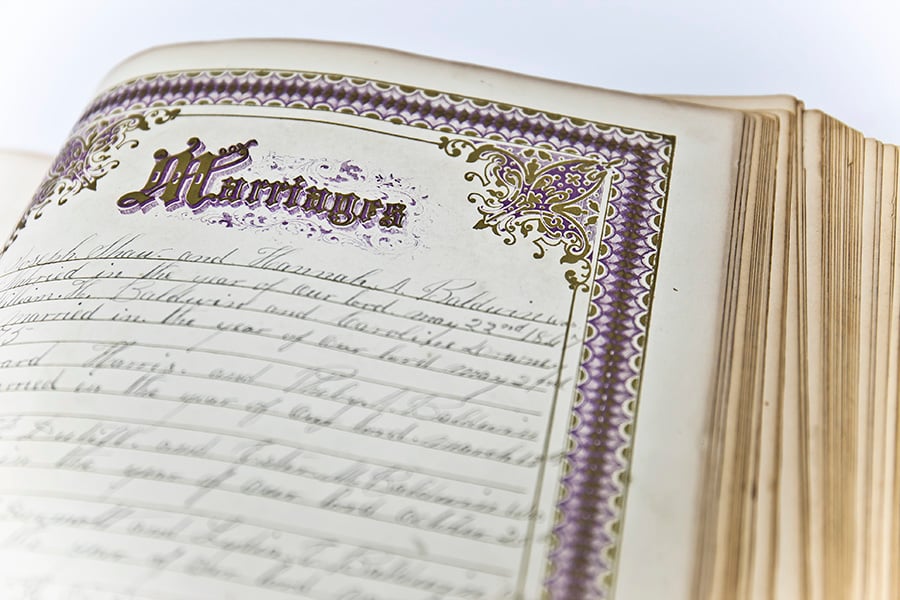
The Baldwin antique bible includes several pre-printed pages where family members recorded births, deaths, and wedding dates from the mid-1800s to the early 1900s.
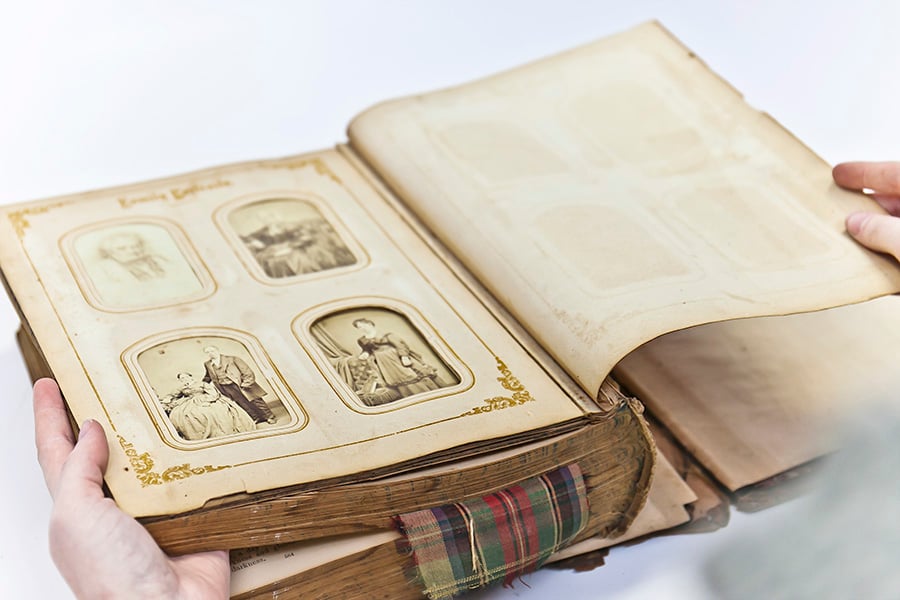
This antique bible was manufactured with the photo-holding pages bound into the book. The Baldwin family used the pages to store family photographs and it literally served as the family scrapbook from the 1870s through the 1920s.
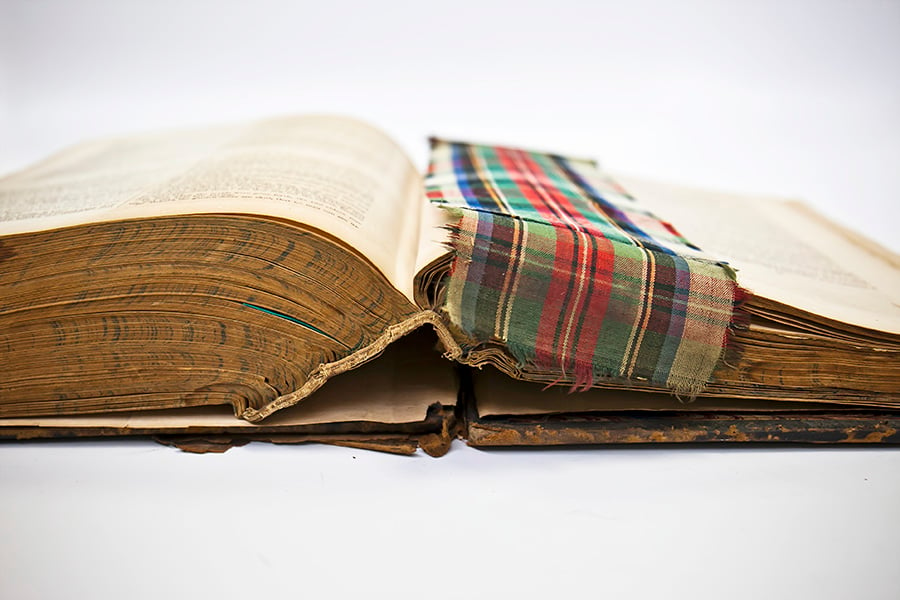
A handmade cloth bookmark used by the Baldwin family in their bible.
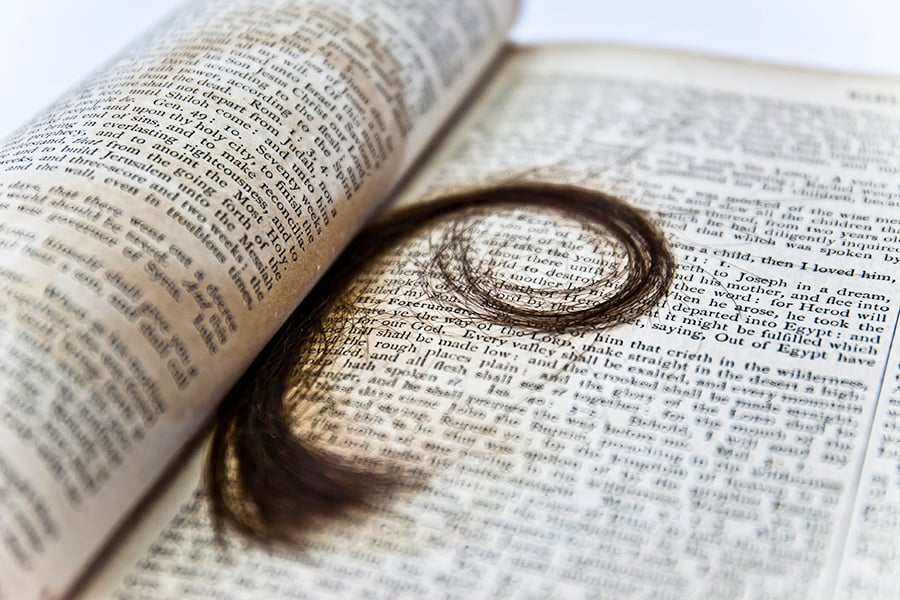
A lock of hair was stored inside the pages of this antique bible for nearly 150 years. The practice of keeping locks of hair in scrapbooks was not common until the mid-to-late 1900s. This is one of the earliest examples of this practice.
Folios with Images
During this same period, the 1600s and 1700s, the first albums with images were being compiled. These albums were created from collections of prints, etchings, drawings, and other artwork. The folios were often stored in what was called a Wunderkammer, or a "cabinet of curiosities" that was used to display natural and historical relics.
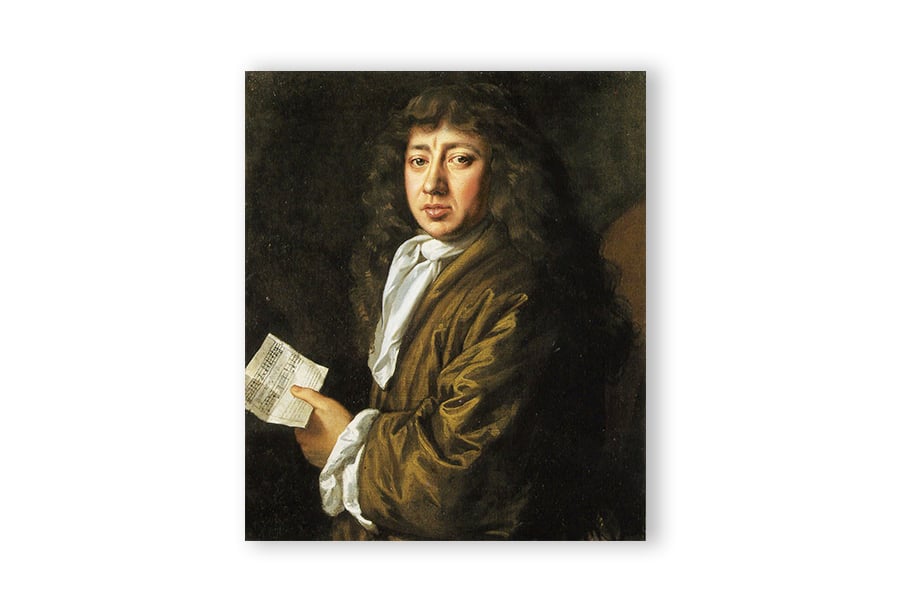
A portrait of Samuel Pepys.
Samuel Pepys, a Member of Parliament and Naval Administrator, was just one of the educated elite of the 1600s who combined several of these pursuits. Most people are familiar with Pepys (pronounced "peeps") because of his diaries containing accounts of life in 1660s London, which were made famous when they were published in 1825. Along with that, he also amassed a library of bound folios containing an extensive collection of images he had collected and curated from all around Europe. In the last years of his life, Pepys became so obsessed with assembling bound books of his collection of prints that he even kept a professional bookbinder on retainer!
Extra-Illustrated Books and Grangerizing
Today's bible journaling could be seen as the 21st century descendant of the grangerized Bibles of the 18th and 19th century.
In the late 1700s, the practice of "extra-illustrating" books became popular, in which people customized books by adding extra illustration leaves to them. Sometimes the illustrations were added right onto existing pages in the book, or sometimes the book's binding was completely taken apart so that additional pages could be bound inside to hold the illustrations. The practice was (and is) controversial, as it was necessarily destructive due to having to obtain the illustrations by removing them from other books or by having to add additional pages to a book's binding.
Extra-illustrating was popularized by James Granger, author of the 1769 book "Biographical History of England." The book was published with extra blank pages in the back to encourage readers to add their own illustrations. The immense popularity of Granger's book led to the use of the term "Grangerizing" to describe the practice of extra-illustrating. Some of the most significant extra-illustrated works from the late 1700s come from Samuel Rudder and Count Hamilton Anthony. Samples of their books - displayed at the Huntington Library - are shown below.
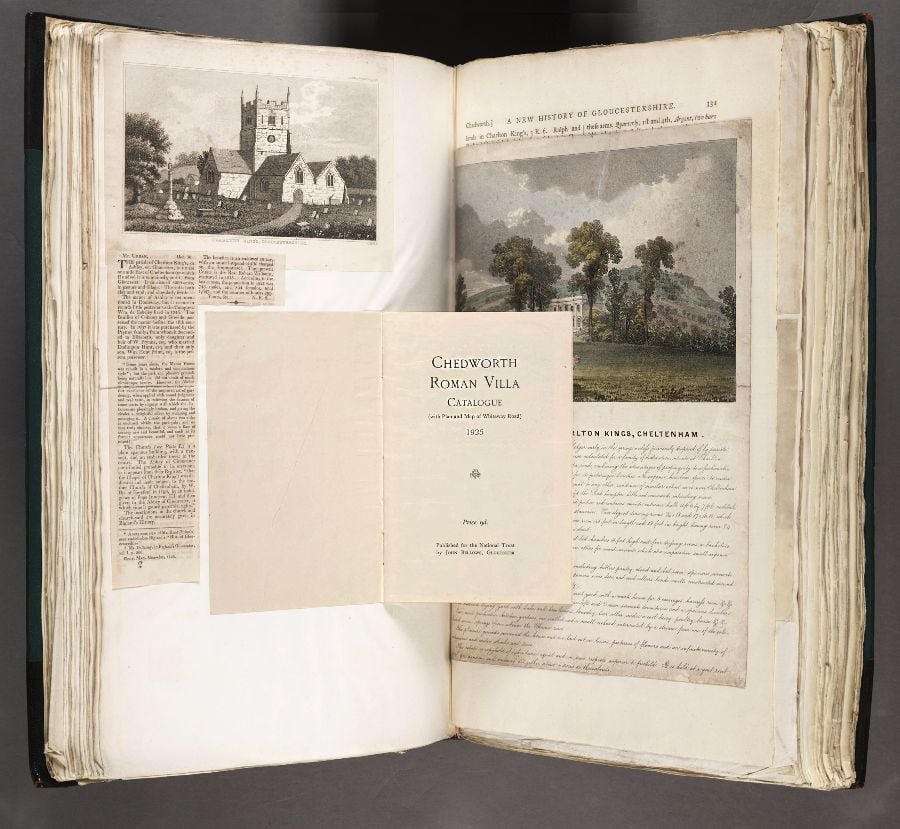
Samuel Rudder, A New History of Gloucestershire. Cirencester, from the year 1779. Huntington Library, Art Collections, and Botanical Gardens. Copyright Huntington Library.
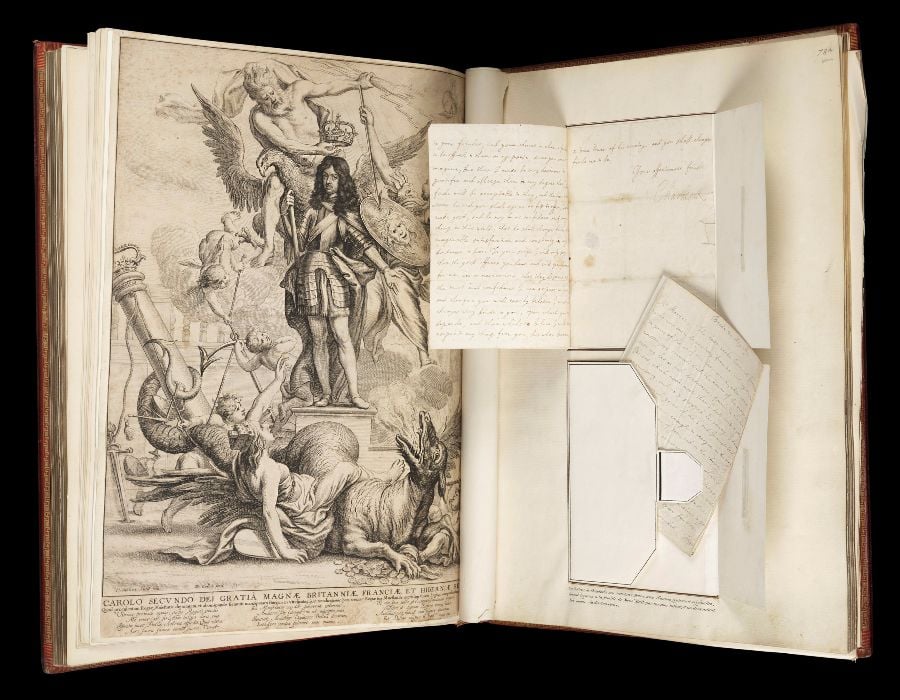
Anthony, Count Hamilton, Mémoires du comte de Grammont. London, from the year 1794. Illustrated by Richard Bull. Huntington Library, Art Collections, and Botanical Gardens. Copyright Huntington Library.
Grangerizing or extra-illustrating remained popular well into the 1800s, and one of the most common volumes to extra-illustrate was the bible. The Kitto Bible is one of the most famous illustrated bibles. It is also in the collection of the Huntington Library. The Kitto Bible started as a two-volume publication but was grangerized into a massive 60-volume set containing over 30,000 illustrations by James Gibbs in the mid-1800s. Today's bible journaling could be seen as the 21st century descendant of the personal expression and customization that was done in the Kitto Bible and other grangerized Bibles of the 18th and 19th century.
Scrapbooks for Political and Social Change
Grangerizing and scrapbooking weren't just hobbies – they were also sometimes used as tools of political subversion and change. During the English Reformation, it is believed that Catholics who wished to appear as loyal members of the new Church of England (since to appear otherwise was considered treason) would paste images of Catholic saints into their Church of England Bibles and prayer books.
In 1839, a group of early slavery abolitionists from the American Anti-Slavery Society published a book called "American Slavery As It Is: Testimony of a Thousand Witnesses." The book was an account of the actual treatment of slaves by their owners, based on a scrapbook of newspaper accounts assembled by the group, and is still considered to have been a very powerful tool in the abolition movement.
The Industrial Printing Press
Throughout the 19th century, scrapbooks that more closely resemble what we think of as a scrapbook today began to emerge – compilations of personal memories. Several technological changes during the 1800s drove this development, creating the basis for the art form that is still practiced today.
Most importantly, the development of the industrial printing press in the early 1800s was instrumental to modern-day scrapbooking. When printing presses switched from being hand powered to being mechanically powered, it made the mass production of printed materials possible in a way that had never before been seen. Elaborately printed greeting cards, calling cards, postcards, prayer cards, advertising trading cards, and other materials were now viewed as novelty keepsakes by the recipients.
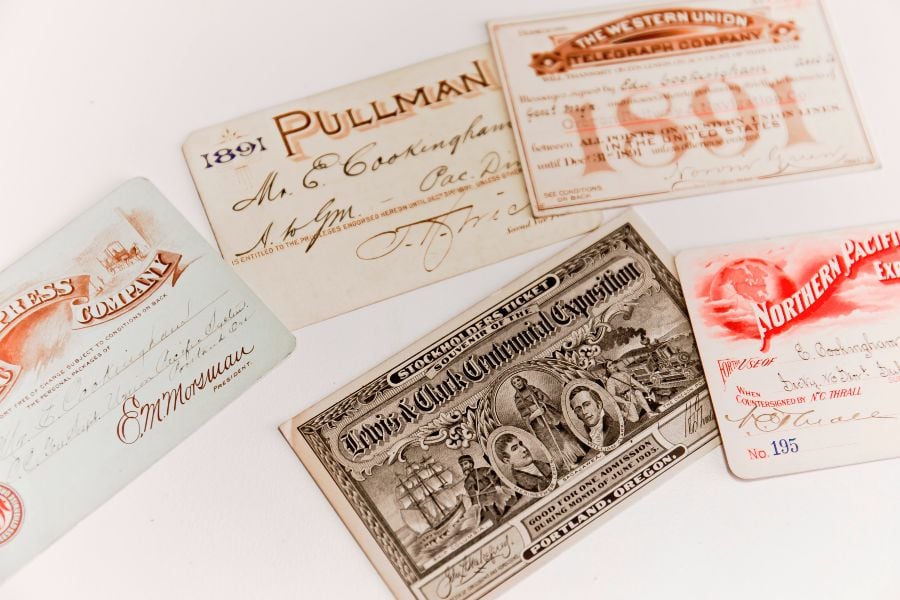
A collection of early printed tickets and cards from the 1880s and 1890s.
Newspapers went into widespread circulation as well, and readers clipped everything from family mentions to recipes to historic news stories to save.
Books of Scraps
During the 1800s, the emergence and increased accessibility of printed material sparked a new trend. People began filling blank, bound books - previously used for journals or artwork - with clippings, cards and printed memorabilia. Some of these books contained a mix of personal journal entries, hand-drawn sketches, and watercolors, along with various scraps of printed material. These books were literally books of scraps.
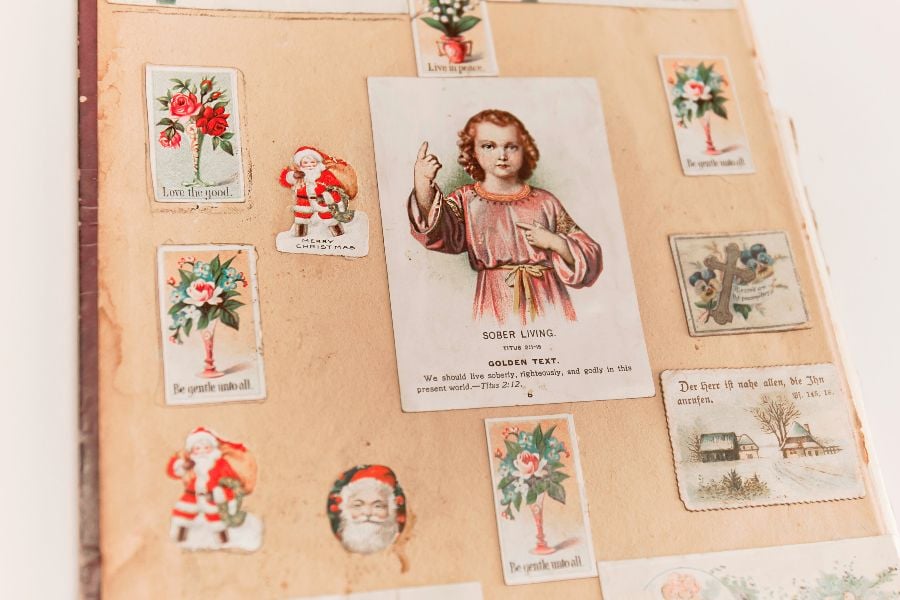
A book of scraps from the late 1880s. Features several printed materials collected and pasted inside.
Calling Card Albums
Previously, academics and scholars – a largely male group at the time, had engaged in activities such as compiling commonplace books and grangerizing. However, there was a new focus on so-called "friendship albums," and preserving family materials in blank books, so "scrapbooking" became a more feminine pursuit in the later 1800s.
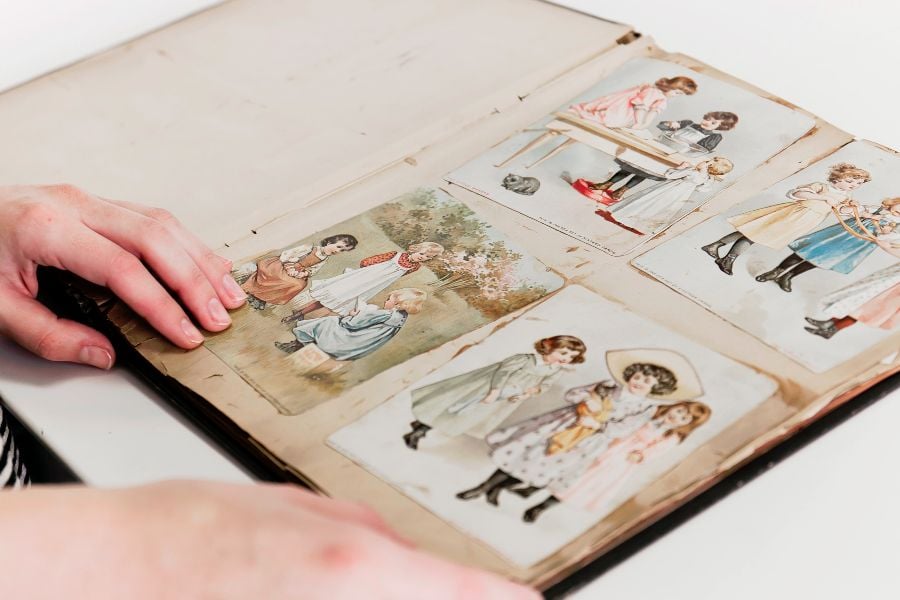
A collection of calling cards, preserved in an album.
This was epitomized by the popularity of calling card albums. Calling cards had long been used as a form of social etiquette, especially in England. Elaborate rules dictated how cards were used to make attempts at social contacts and to accept or decline them. They were also used as a way to politely extend social greetings after an event like a birth or wedding.
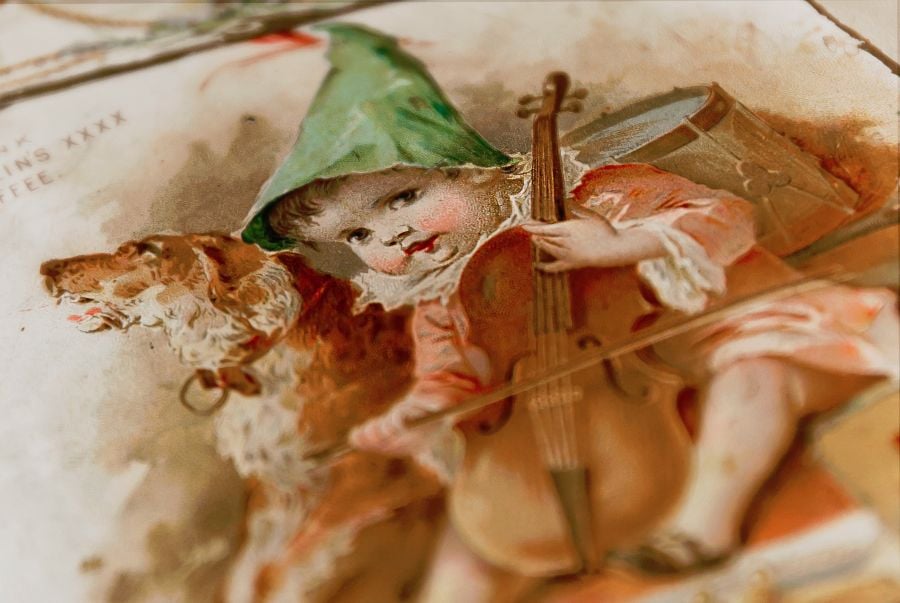
Close up photograph of a beautifully illustrated calling card.
In a world where social elites hid behind a wall of servants, and etiquette was extremely rigid, you didn't just drop in for a visit with someone. Instead, a card would be dropped off – with the corner folded to indicate it was delivered in person. If the person wished to receive a visit, then a card would be delivered back to them. A card delivered in an envelope, however, was a polite brush-off.
It wasn't just the etiquette that was elaborate. Like so many other things in Victorian times, the cards were decorated with beautiful floral designs and pastoral scenes. The desire to preserve these beautiful pieces of full-color printing (which was still a relatively new technology) and remember friendships, led to the growth of calling card albums. Page after page would be filled with beautiful cards by social ladies.
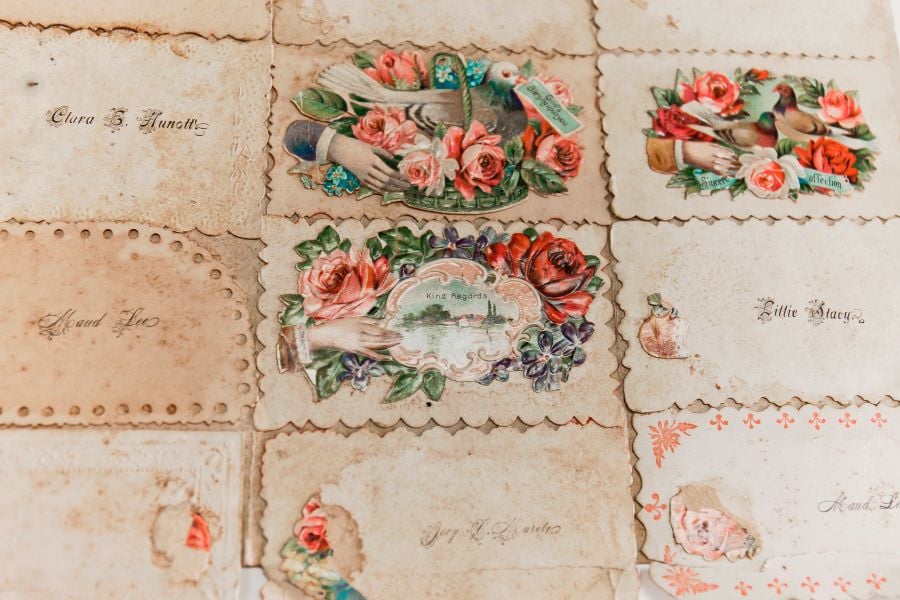
Antique calling cards from the late 1800s, collected over time and pasted onto a page for safe-keeping.
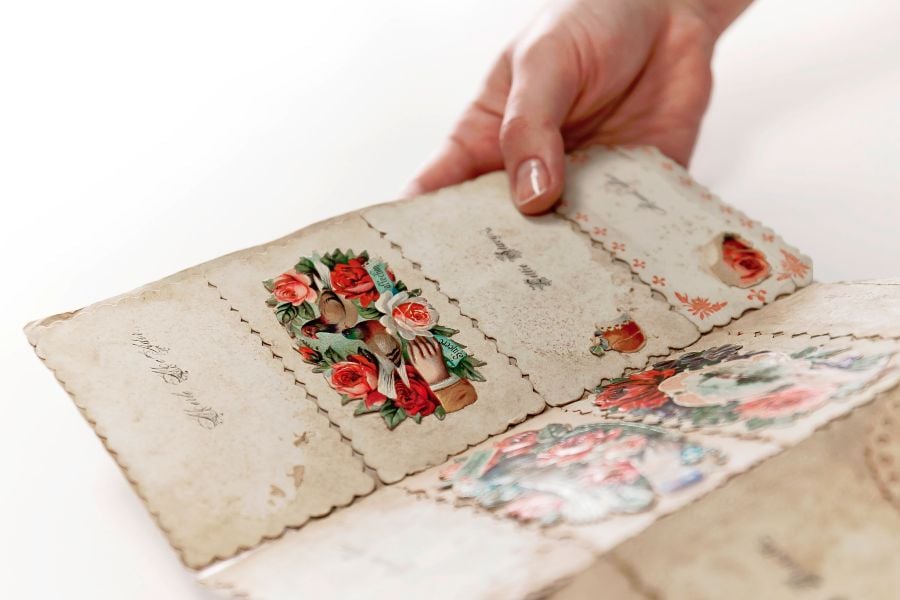
Close-up of antique calling cards pasted onto a page for safe-keeping from the late 1800s.
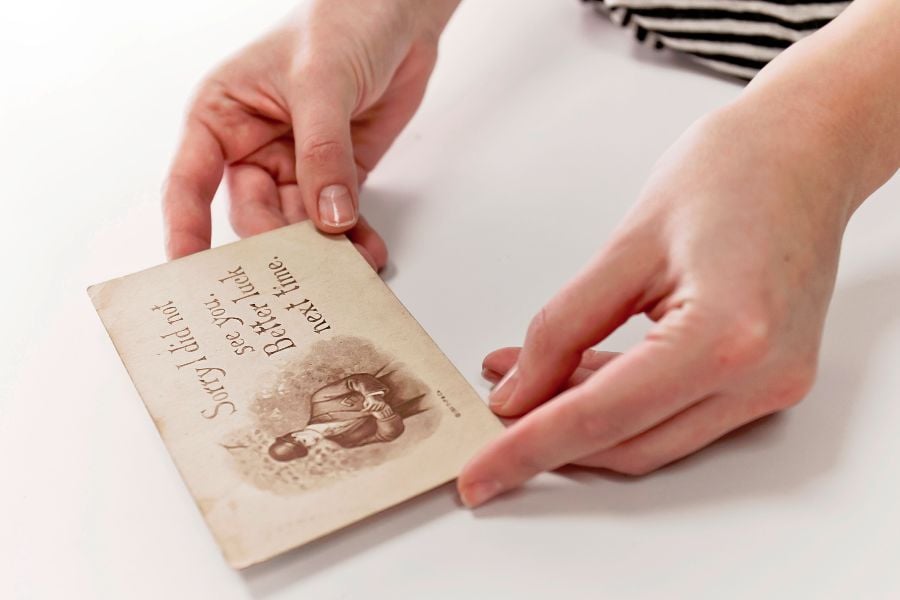
A "reply" calling card from the early 1900s.
Recipe Albums
During the late 1800s and early 1900s, cooking magazines like Gourmet Magazine, rose in popularity, giving homemakers a larger selection of printed recipes to choose from. Women, primarily, began collecting printed recipes and storing them in books or binders. These quasi-scrapbooks often contained hand-written family recipes alongside recipes from the local newspaper or from cooking magazines.
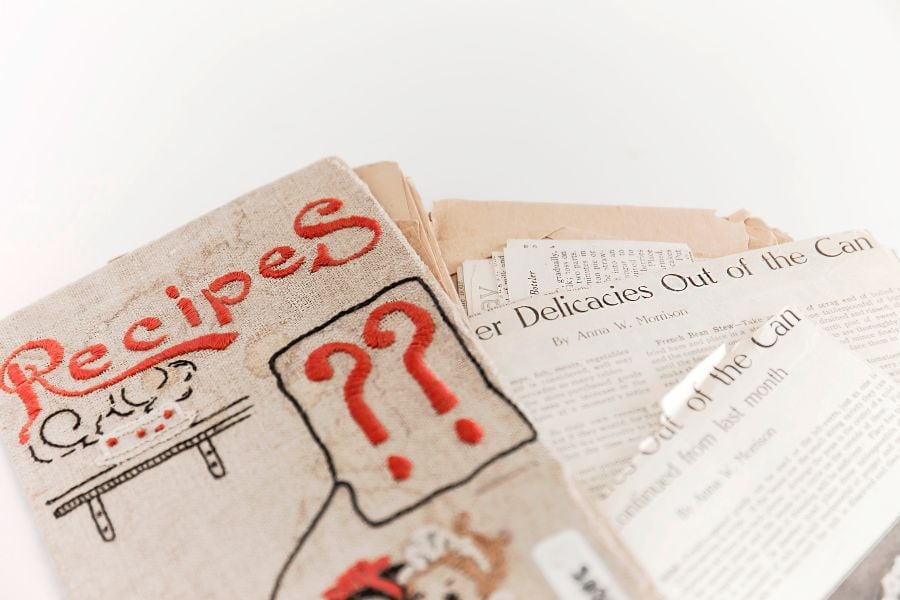
Ths antique recipe book contains printed recipes dating from 1905 to 1960. It includes clippings from newspapers and magazines plus hand-written family recipes.
Invention of Photography
One final invention was needed for scrapbooking to reach its currently recognizable form, of course: photography. Joseph Niépce took the first photograph in 1827, but those early photos were rudimentary and the pictures were fuzzy. Furthermore, the process was laborious and Niépce's photos needed eight hours of exposure to light. In 1837, however, Louis Daguerre developed a new method of photographing that created a sharper picture and took only a few minutes, versus hours. It was a marked improvement on the first photographs.
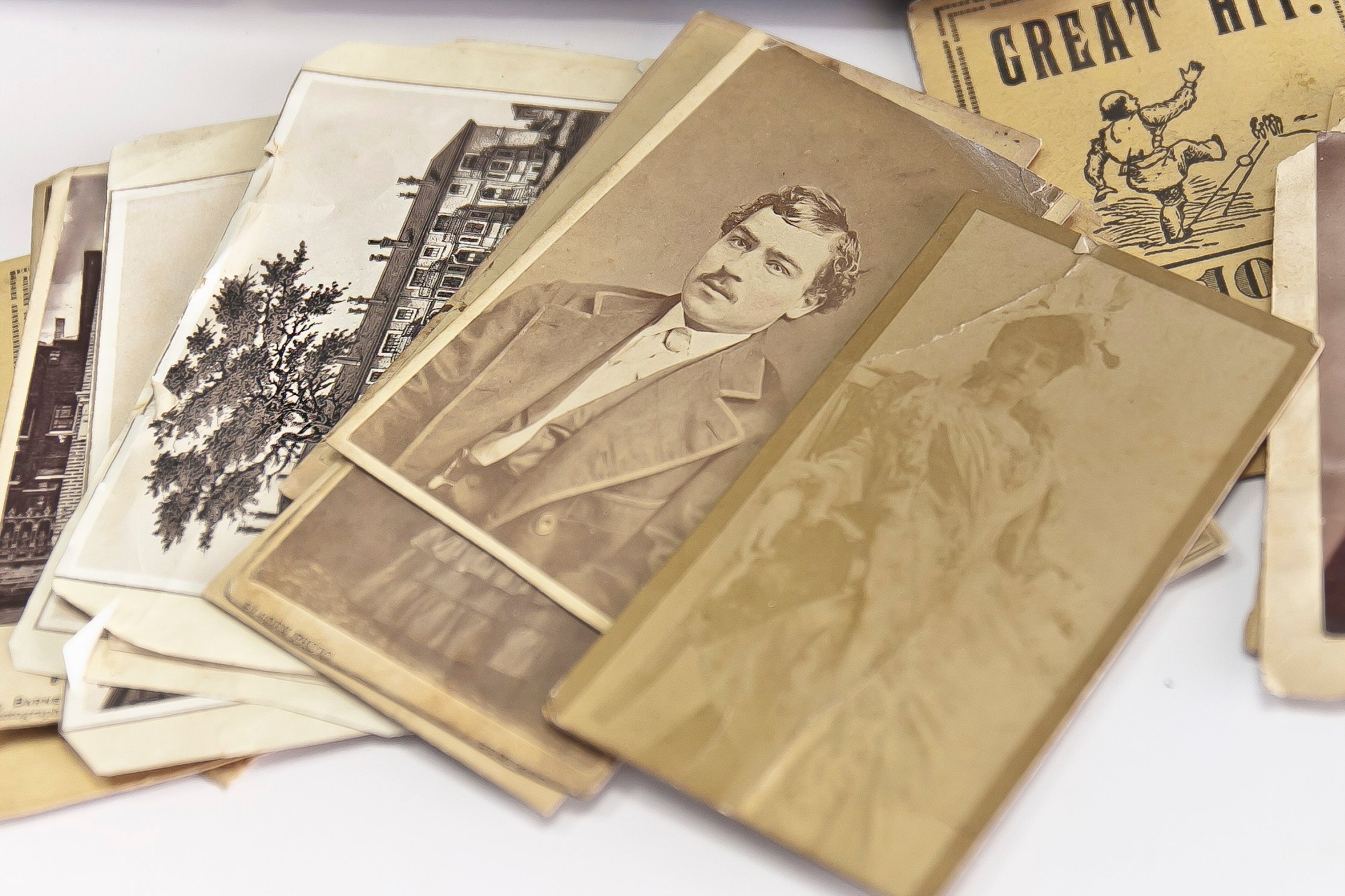
Examples of cartes de visite from the mid 1800s.
By the late 1850s, a form of photography called carte de visite (visit card)started to spread across the United States from Europe. These small photos were about the size of a calling card and were especially popular during the Civil War. Cartes de visite were printed in sheets of eight photographs, and it was common to trade them with friends and family or purchase prints of celebrities. This led to the desire to preserve the collected photos in albums – creating the first true scrapbooks!
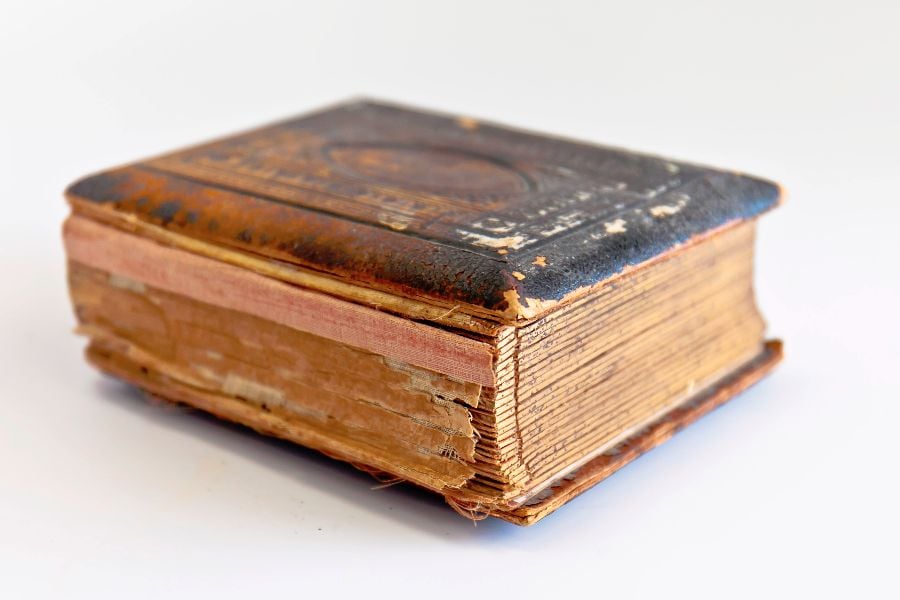
A photo album from the mid-1860s. It holds cartes de visite sized photos and memorabilia from that time period as well. It is the oldest album we have been able to locate that combines memorabilia "scraps" with photos in the same book.
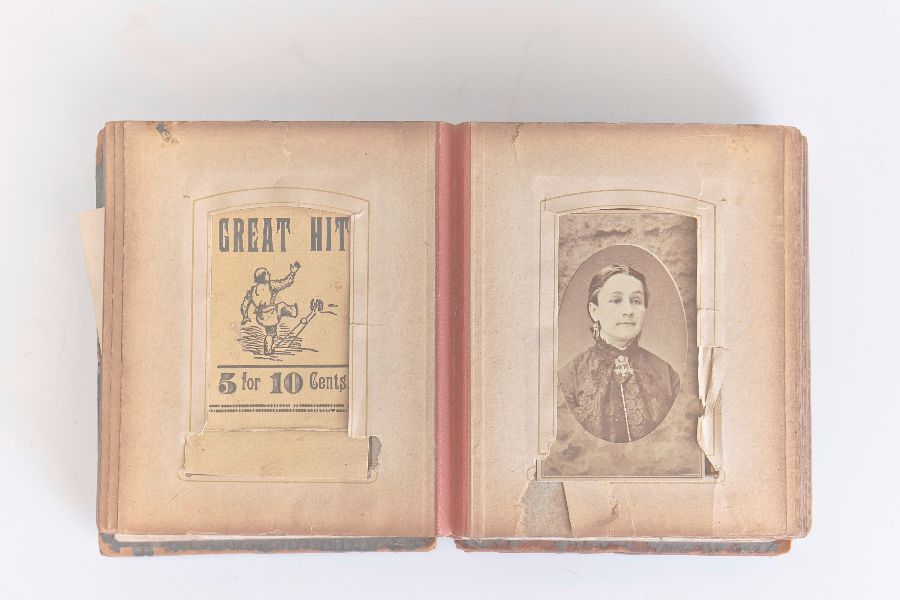
This rare 1860s era photo album contains over a dozen cartes de visite antique photos and memorabilia cards dated between 1862 and 1880. The combining of photos and memorabilia together was quite rare in this time period and was not widely adopted until nearly 50 years later.
Families began keeping albums full of photos of family members. Because of the long shutter speed, subjects had to hold still for the duration of the photo. Therefore, most early photographs of people showed them with little or no emotion because it was easier to hold a pose without facial expression.
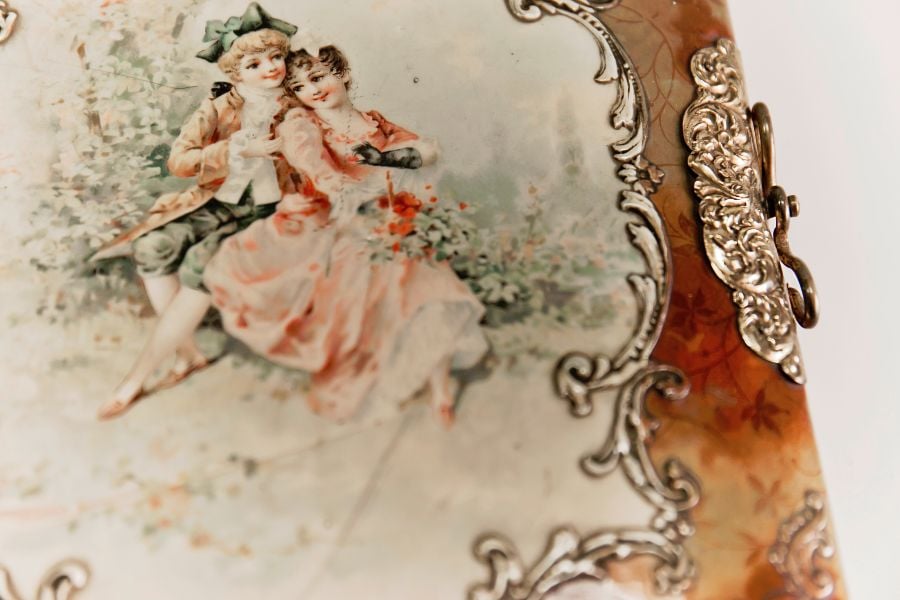
This beautiful antique photo album contains photo portraits from 1890 to 1912. The album features an illustrated cover and locking clasp on the side.
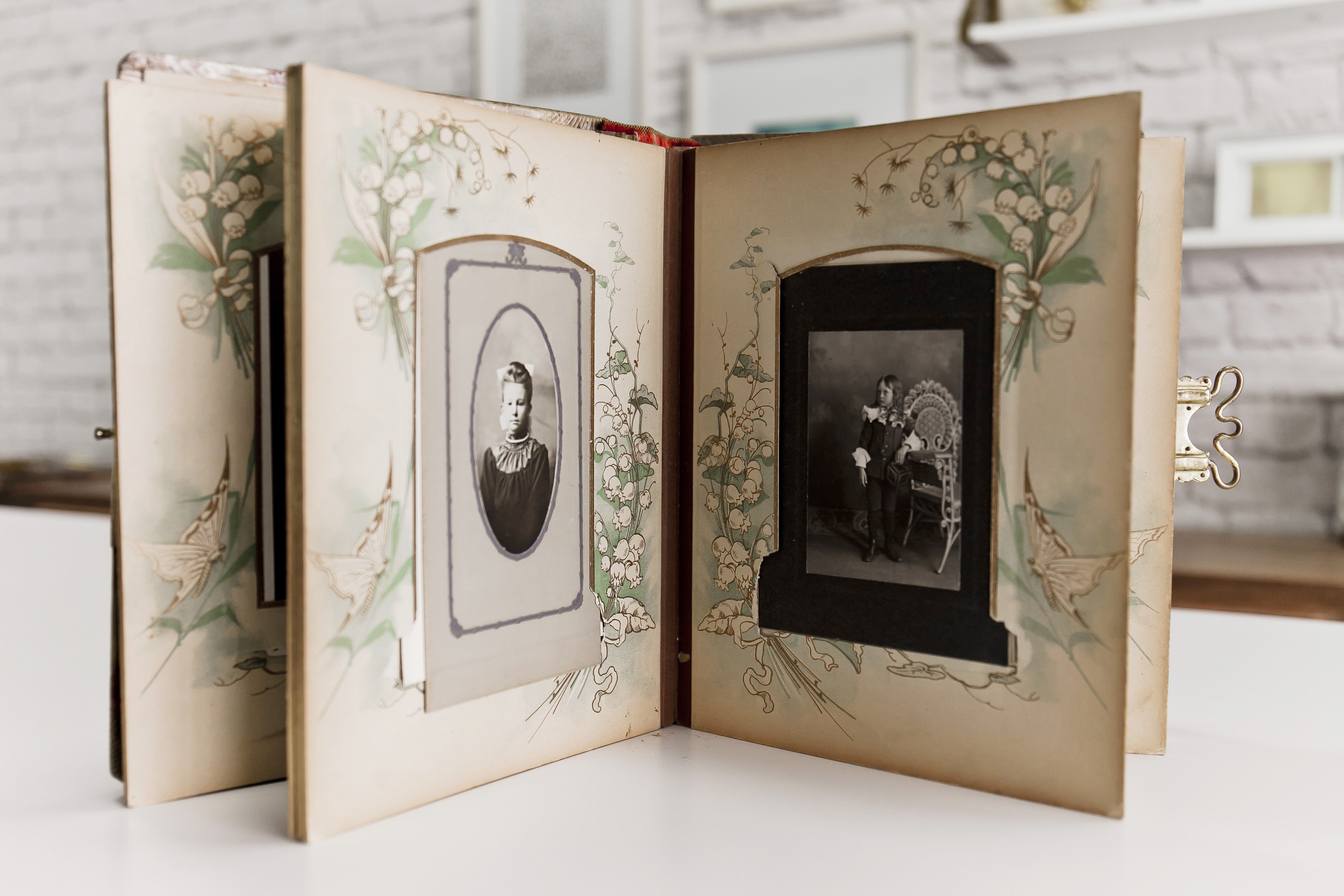
The portrait-style photographs inside the album date from 1890 to 1912.
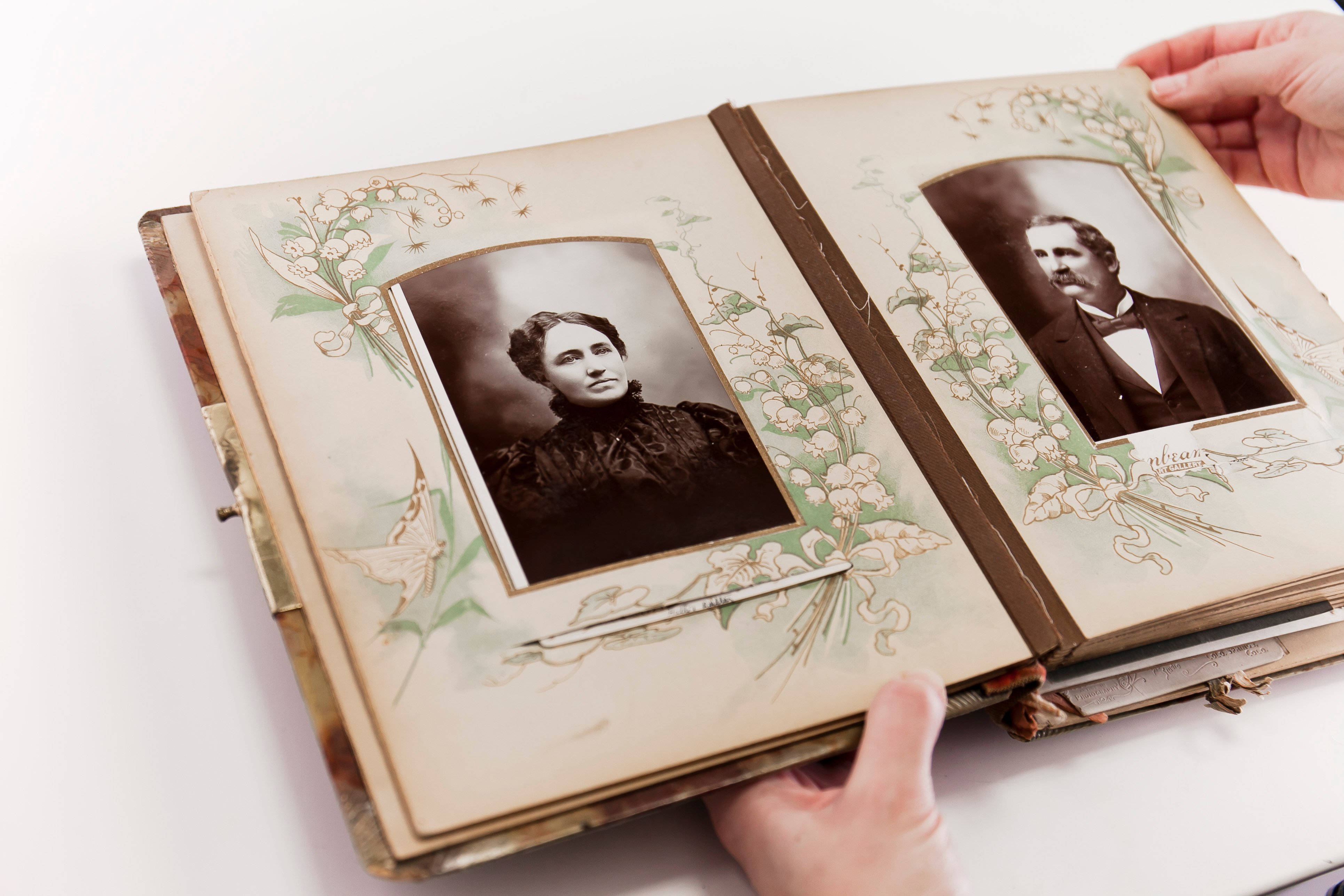
Close-up of a photograph in the original vintage photo album. These photographs are from the early 1900s.
Coining of the Word Scrapbook
The 1800s also brought the creation of the word "scrapbook". The first recorded use of the noun "scrap book," to refer to a book with blank pages for pasting items into, is believed to be in 1821. The first use of "scrapbook" as a verb was recorded in 1879.
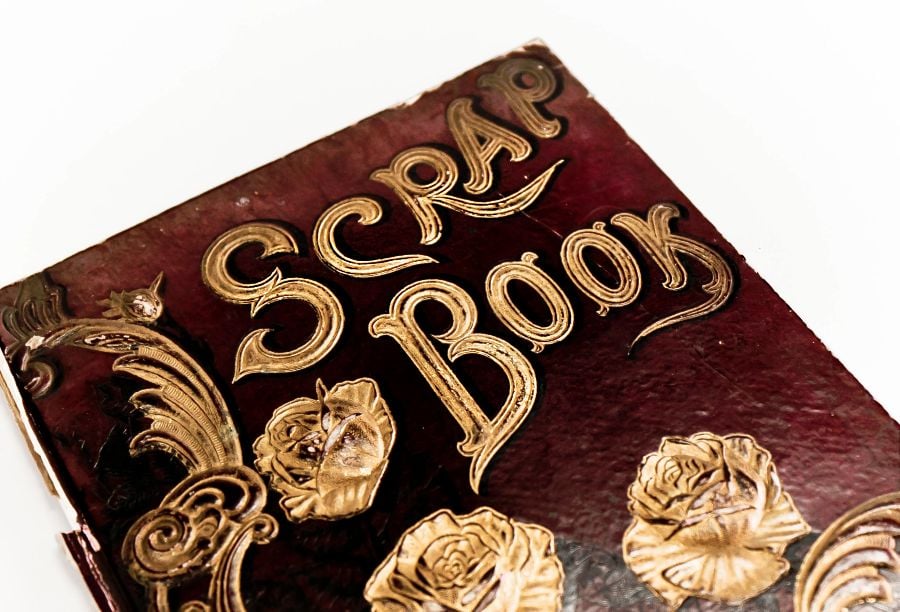
The cover of a scrapbook produced in the 1800s.
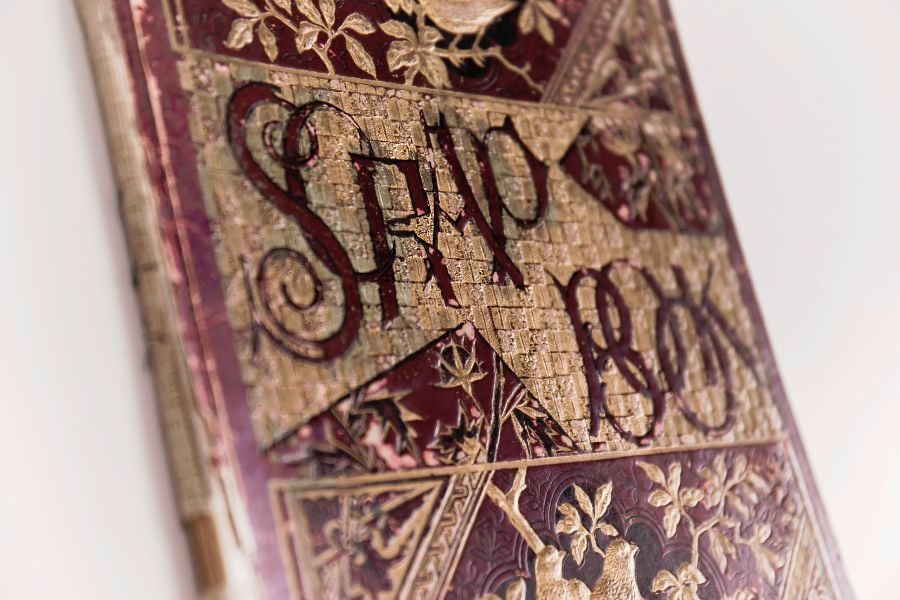
Another cover of a scrapbook produced in the 1800s.
Originally the term was seen as two words "scrap book" or hyphenated as "scrap-book" but over time, the two words morphed into one and the accepted and preferred spelling today is one word - "scrapbook".
Mark Twain's Patented Scrapbook
In the late 1800s, with the rising interest in scrapbooks, companies began selling blank scrapbook albums and glue. Mark Twain, more widely known as a writer than an inventor, created and patented a self-pasting scrapbook in 1872. The book contained adhesive in a grid pattern that was already on each page.
The album owner need only wet the adhesive ever-so-slightly and then place the clippings, pictures, and other items inside where they would adhere. Twain's scrapbook was wildly successful and varying accounts report Twain earning as much as $100,000 from sales of it – a fortune in those days. That number is even more remarkable considering Twain earned $200,000 from all of his other books combined.
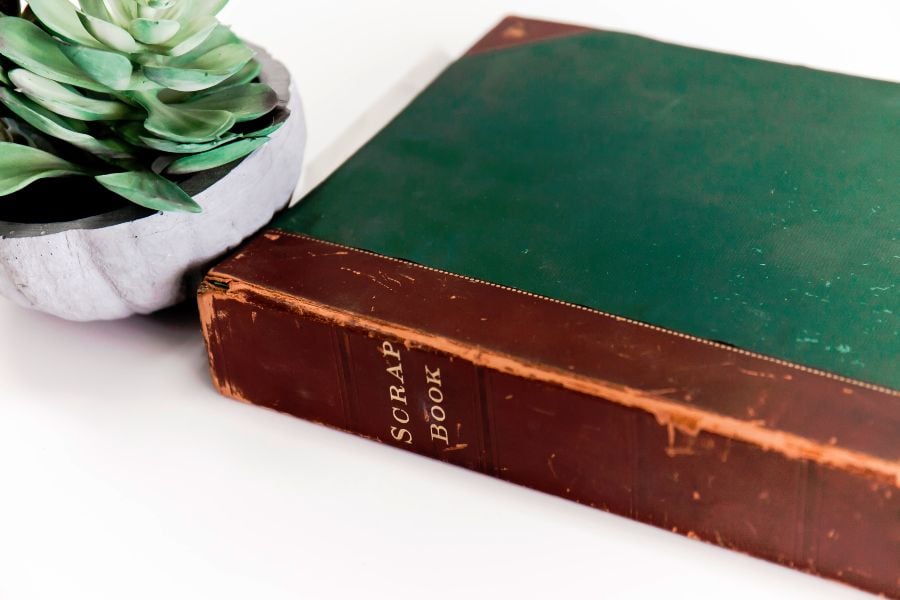
A Scrapbook produced and sold by Mark Twain from the late 1800s. This scrapbook was owned by Mr. Edward Cookingham of Portland, Oregon. He was a prominent figure in Oregon, president of the Portland Symphony, chief banker, and politician. The scrapbook is filled with letters, cards, newspaper clippings, invitations, and photographs from Mr. Cookingham's life. It includes his wedding announcement, an invitation to dine with President William Howard Taft (President of the United States at that time), and more. The Scrapbook starts in 1880 and spans nearly 40 years documenting key moments of his life and events of the time.

Glue from the self-adhering pages in Mr. Cookingham's Mark Twain Scrapbook

The interior of this scrapbook still has the original seal of authenticity inside the front cover.
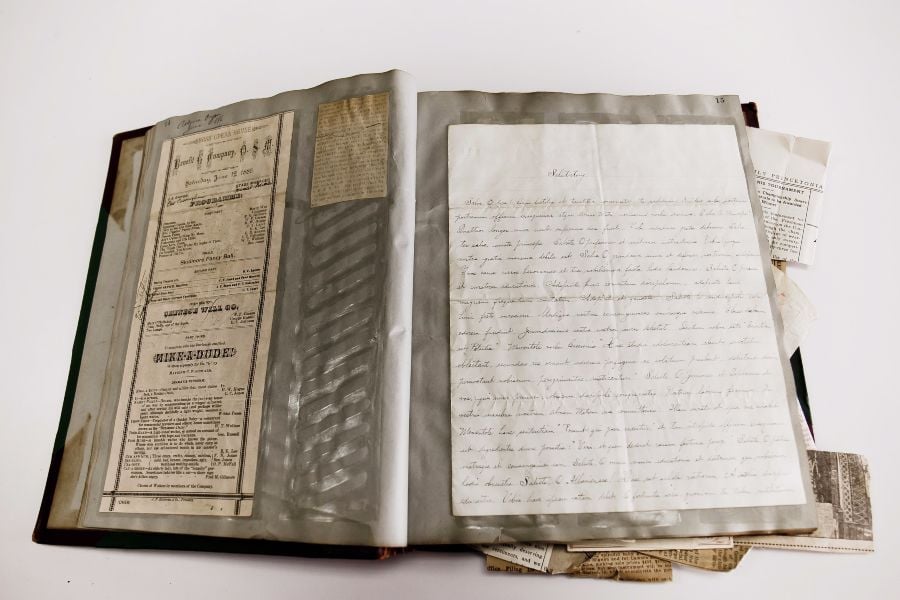
The album contains several newspaper clippings and letters.
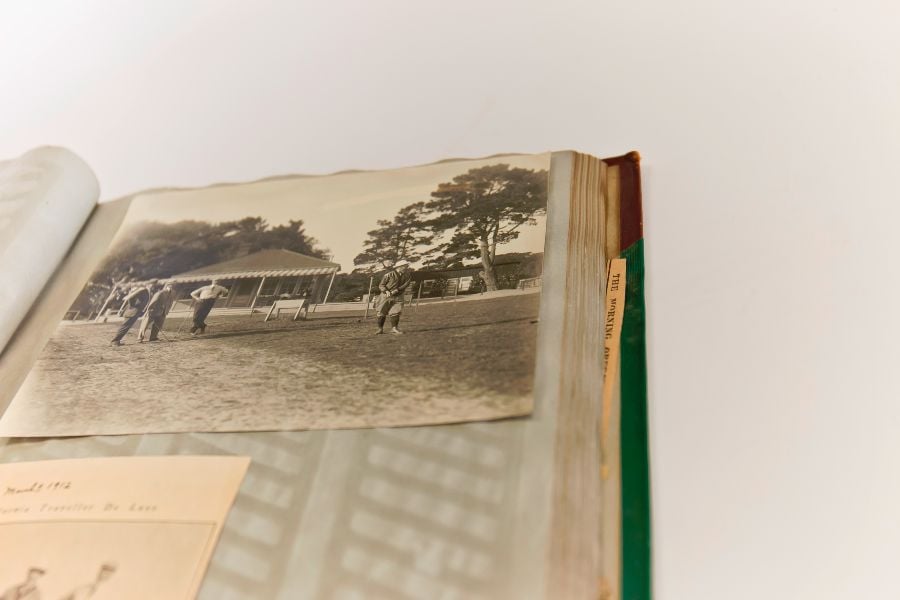
This page contains a few casual photos of Mr. Cookingham playing golf with friends, around 1912.
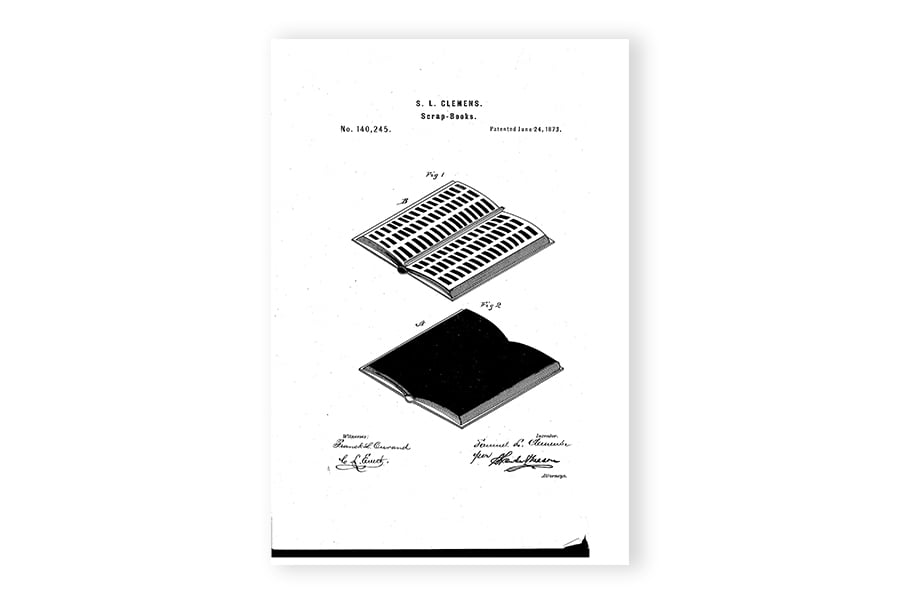
The original patent for the Mark Twain Scrapbook.
The Brownie Camera
"Photography began to reflect everyday life instead of being stiff portraits. The snapshot was born!"
As the 20th century dawned, another invention forever changed the scrapbook: the Brownie camera. Until the introduction of the Brownie camera in 1900, photography was something that was done professionally and mostly in studios, which made it time-sensitive and expensive. The Brownie made photography more affordable to the average family and moved it out of studios and into families' homes. Instead of having their photo taken a few times over the course of their lives, people began to have their photos taken regularly.

Antique Kodak Brownie camera produced in the early 1900s.
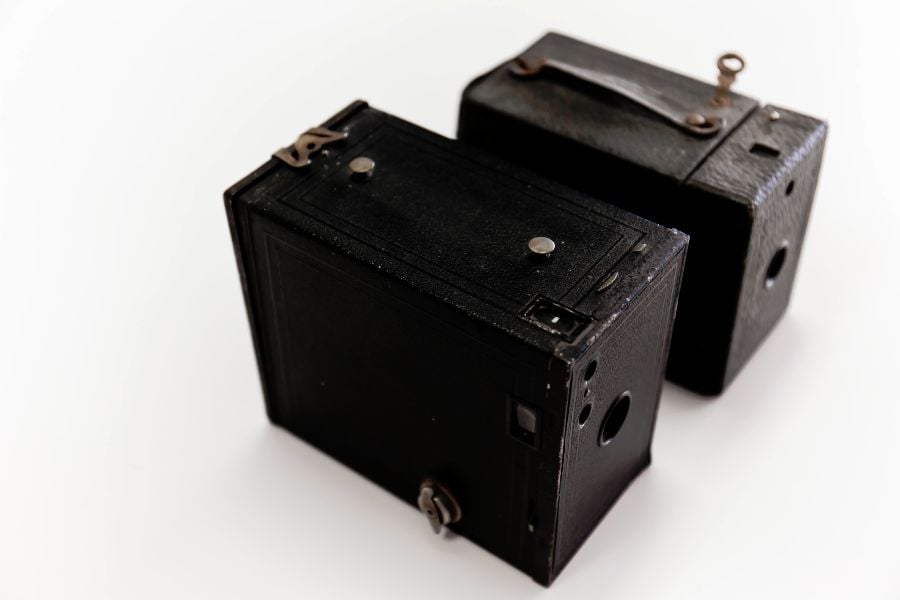
Two antique Kodak Brownie Cameras produced in the early 1900s.
Note: The early models of The Brownie Camera were made with a black-brown leather, but were not named for their color. The Brownie Cameras were actually named after popular illustrated characters of the 1890s and early 1900s called "The Brownies". These cartoon-like characters were used in early marketing initiatives for the camera.
The Brownie didn't just change the frequency of photography – it also changed the type of photos that people took. Photographs were no longer dressed up, formally posed affairs. Affordability, portability, and ease of use allowed the Brownie to be taken on vacation, to the ball field, or even by soldiers to war. Photography began to reflect everyday life. The snapshot was born!

A later version of the Brownie Camera: the Hawkeye from the mid-1950s. This version also included the ability to use flash and was capable of accepting a wide range of Kodak pin and screw flash attachments.
Casual Family Photo Albums and Scrapbooks
With the snapshot came a more modern concept of the family photo album. In contrast to the previous formal albums of staged portraits, these new snapshot albums were much more casual. The current model of scrapbooking is essentially an embellished version of this family photo album that was born from the invention of the Brownie.
By the early 1900s some people began combining casual photos with scraps of important memorabilia, letters and decorative die-cuts and images into the same book in a decorative manner. This practice was uncommon and these scrapbooks combining all of these elements in the same book are quite rare.
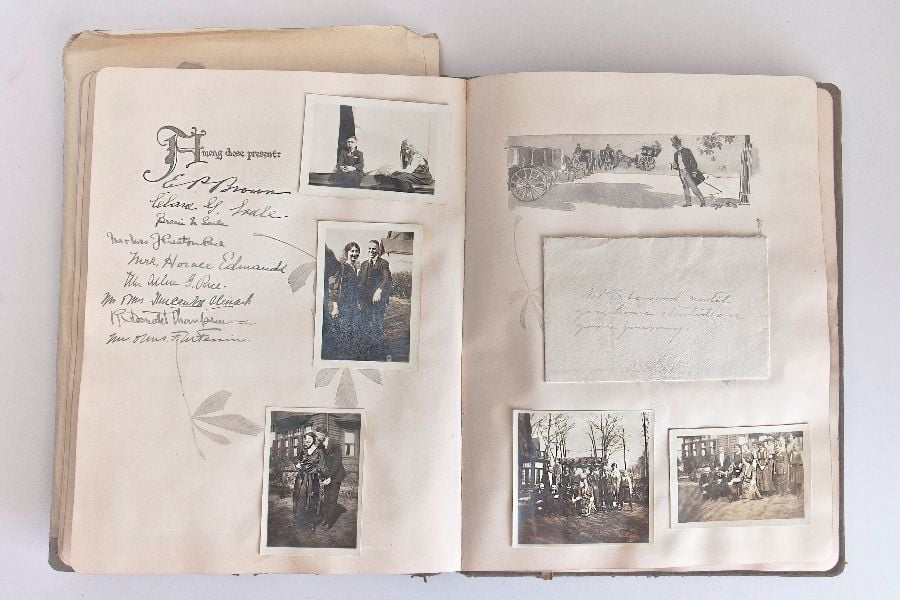
A bride's scrapbook from 1919 - created by Emily Henrietta Fredericks Meyers to document her wedding (May 1st, 1919). This incredible album is the closest approximation to current scrapbooking that we've been able to locate. It includes pre-printed decorative paper pages as the background, casual photos pasted throughout, journaling, letters, and even decorative die-cut shapes. The album is a beautiful work of art that transports you back in time for the wedding, after-party, and honeymoon.
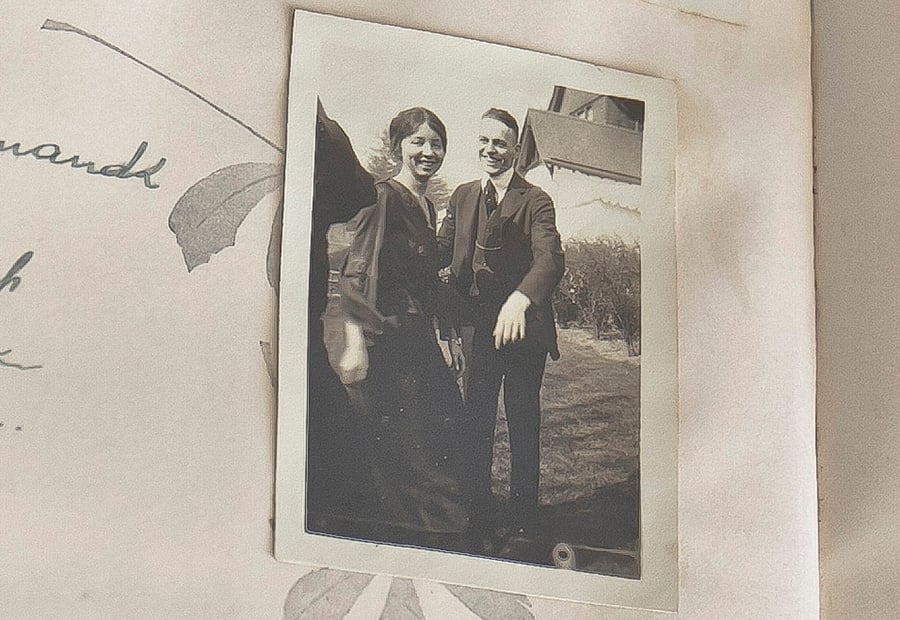
A close-up of the bride (Emily Henrietta Fredericks Meyers) and groom (Lieutenant Charles Henry Meyers) on their wedding day.
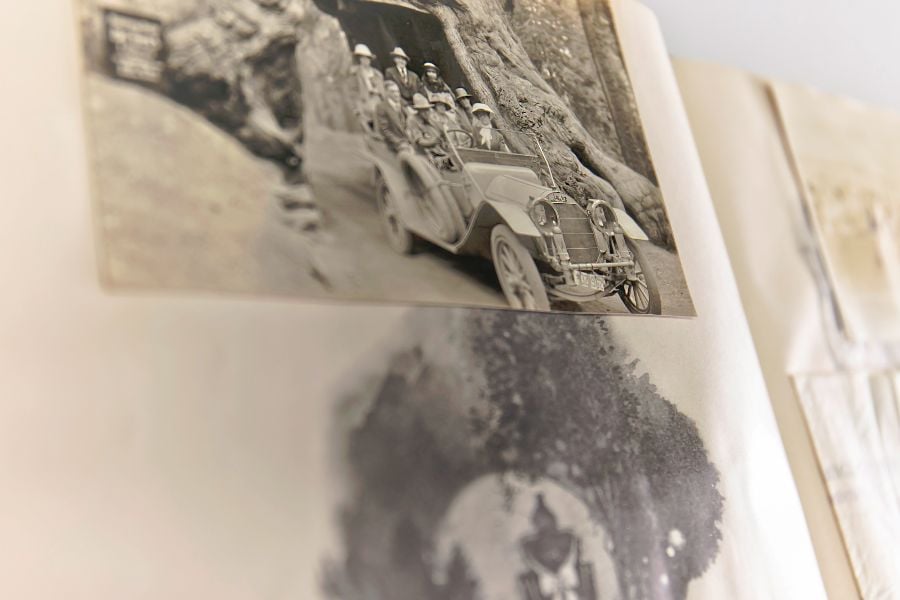
The bride and groom riding in a car on their honeymoon.
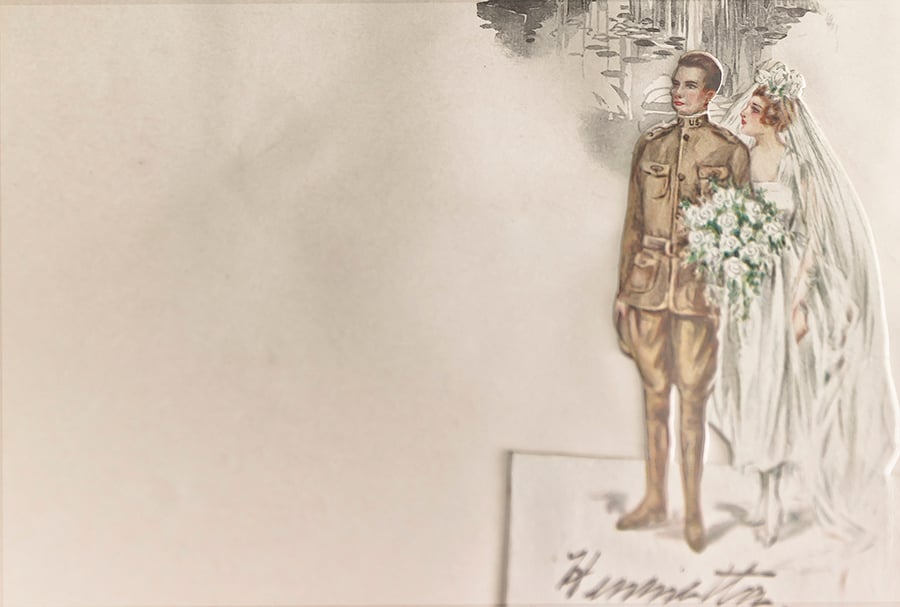
The bride pasted the place cards at the wedding dinner into her scrapbook as decorative "die cuts".
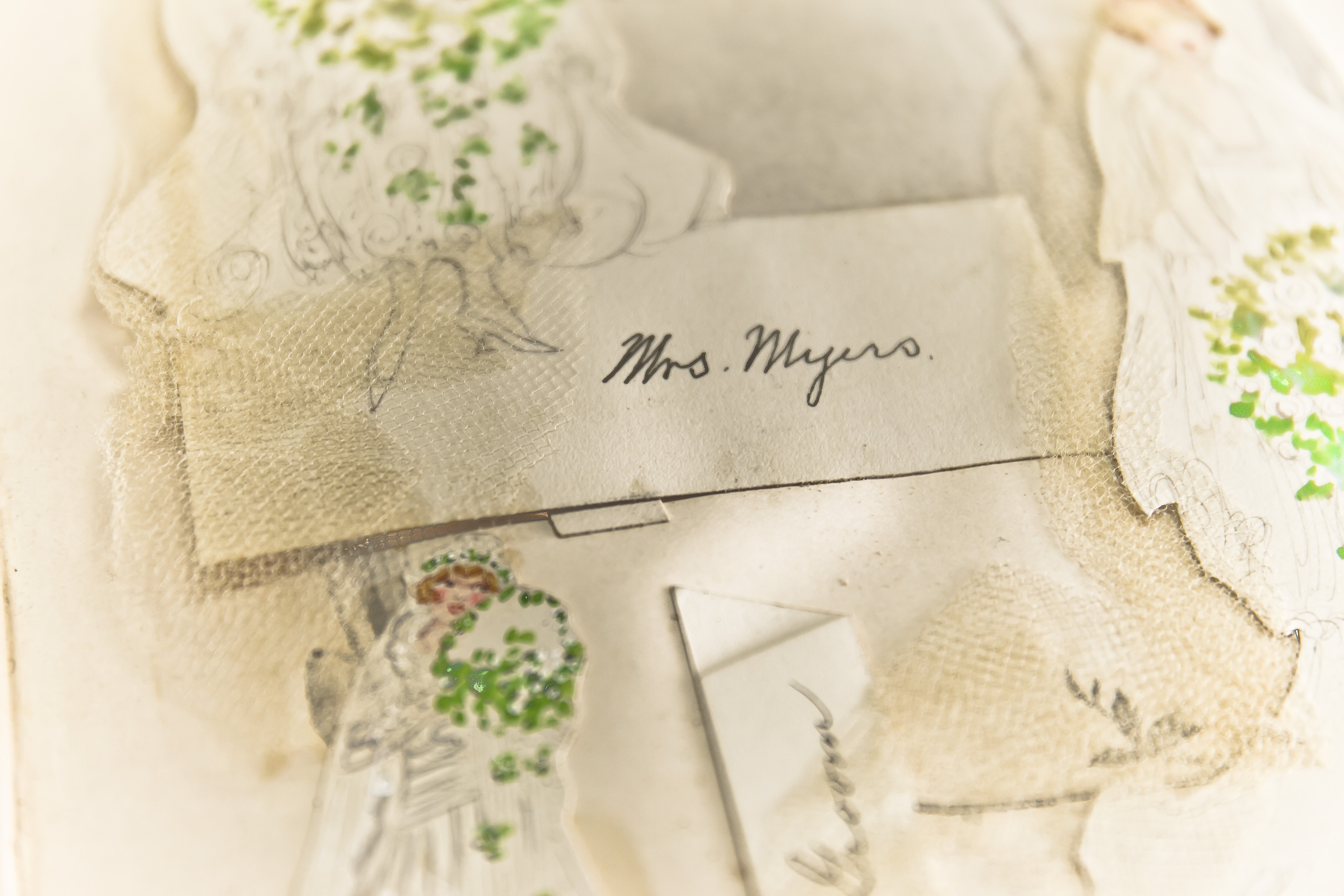
Place cards from a wedding and pieces from the bride's veil used as decorative pieces.
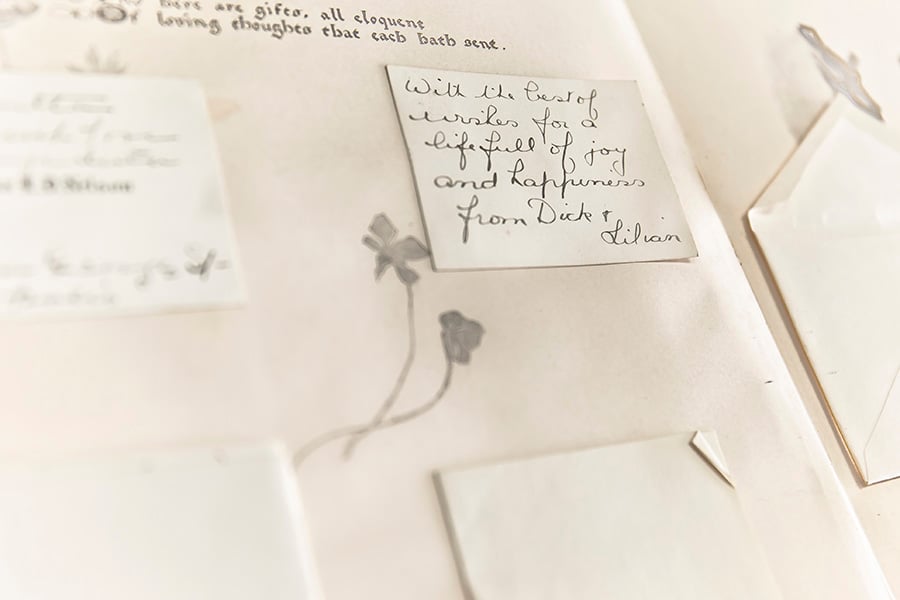
A note to the bride and groom from friends or family members Dick and Lilian. The note says "With the best of wishes for a life full of joy and happiness."
The Evolution of Scrapbooks Through the Mid-1900s
From the early 1920s to the 1970s, scrapbooking slowly evolved. Family pictures were usually kept in an album of paper pages and held in place with glue or photo corners with captions written underneath to provide dates or contextual information. The scrapbook albums of this time frame were usually bound books with empty white, cream-colored or black pages inside for photos and writing.
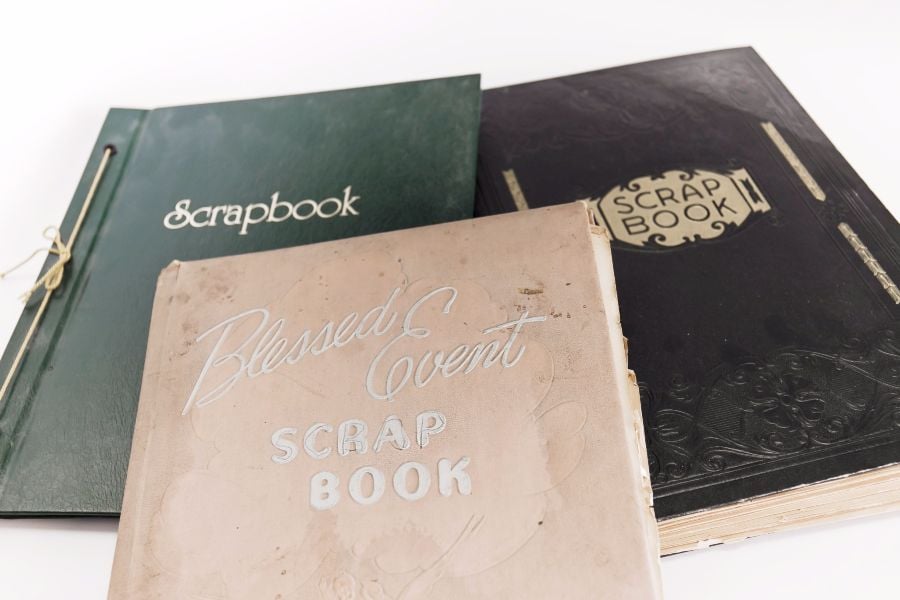
Three different styles of scrapbooks from the 1940s to 1960s.
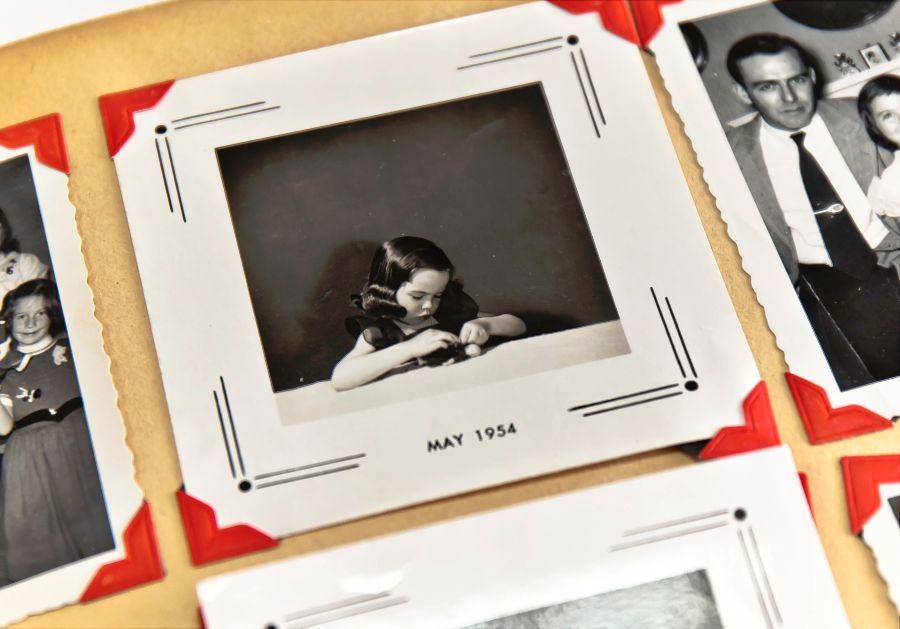
A scrapbook album created in the 1950s, utilizing photo corners to hold the photos in place.
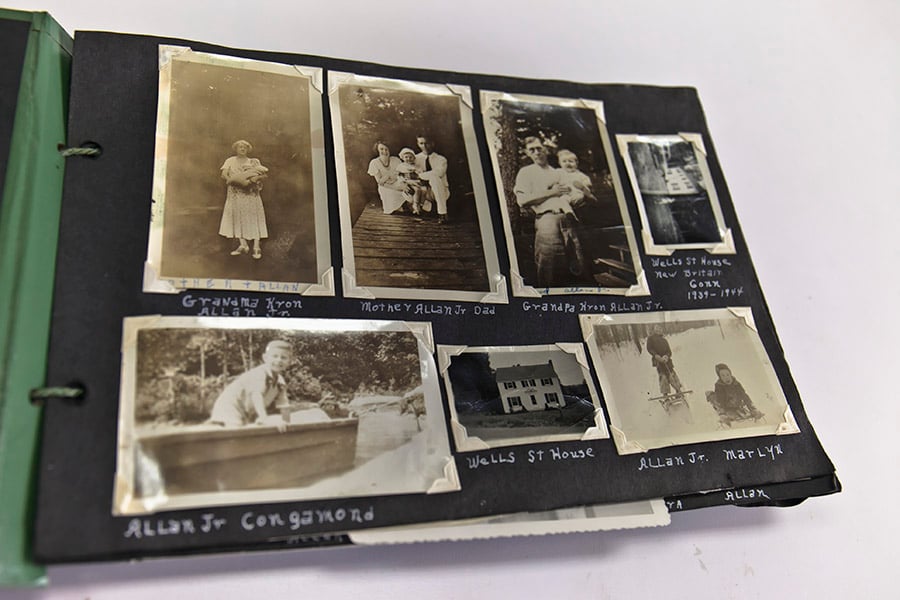
A scrapbook album created in the 1950s-1960s containing photographs as old as the early 1900s. This album features handwritten captions below the photos describing the location, people in the photos, and sometimes some ancillary details about the photos.
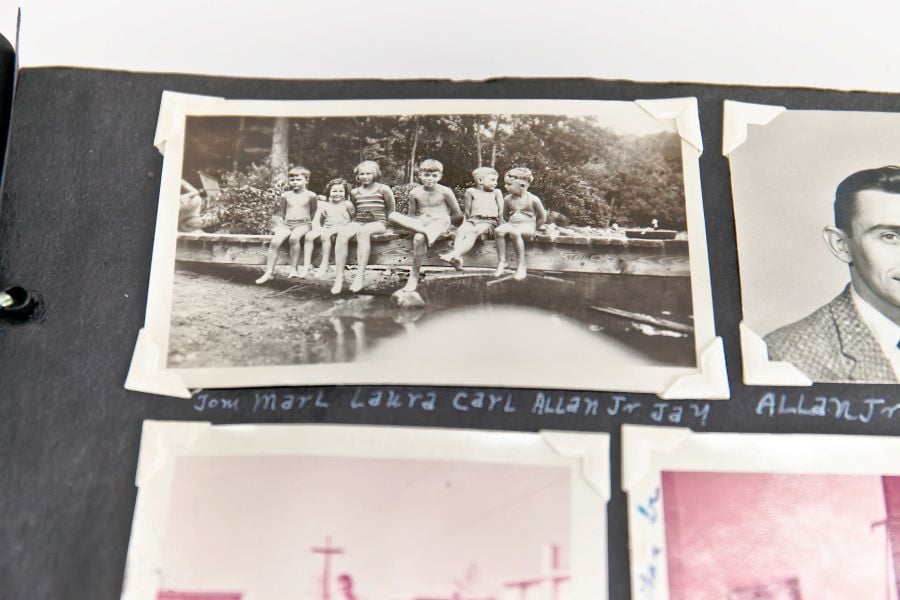
A close up of the 1950s-1960s scrapbook. Features white text on black pages.
Some scrapbooks also came prefabricated with illustrations and questions or suggestions for photos or stories. The most common types of prefabricated scrapbooks were baby books and wedding books.
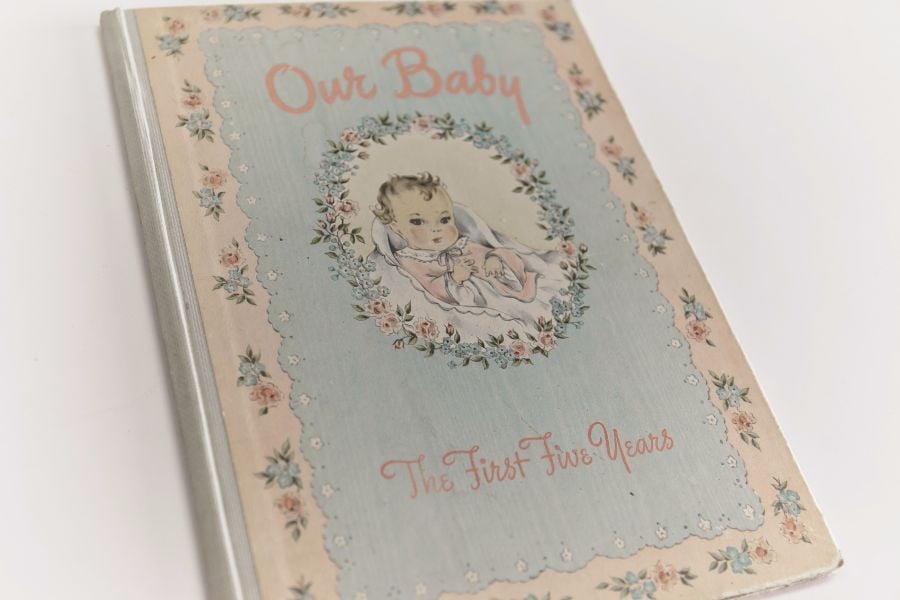
The front cover of a prefabricated baby scrapbook from the 1940s.

An inside page of a prefabricated baby scrapbook made in the 1940s. Journaling is in the form of a note to the baby.
Color Photos
Photography continued to become more common and more affordable as the 20th century progressed. However, something was still missing: color. In the 1960s, color film began to make its way into consumer cameras. By the time Paul Simon was waxing poetic in 1973 about the colors of "Kodachrome" (referencing Kodak's flagship color film) color was the rule rather than the exception in personal photography.
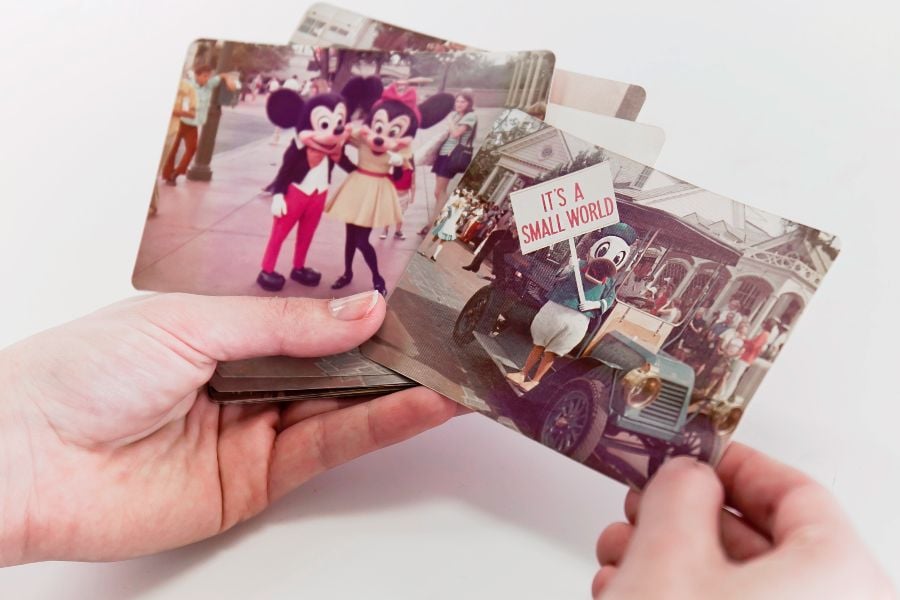
Photos at Disneyland taken in the 1970s on Kodak Kodacolor film.
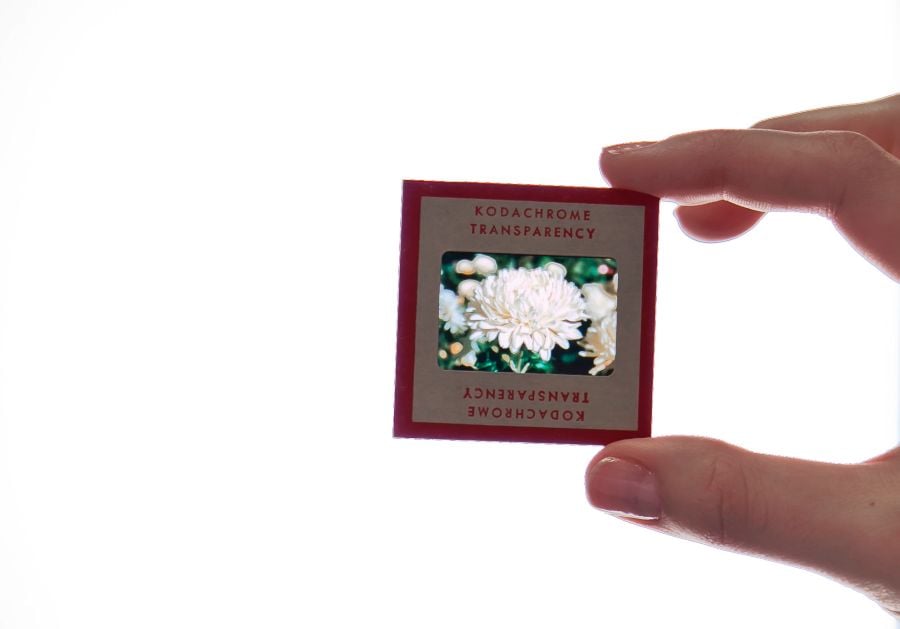
Original Kodachome color slide transparency from the early 1970s
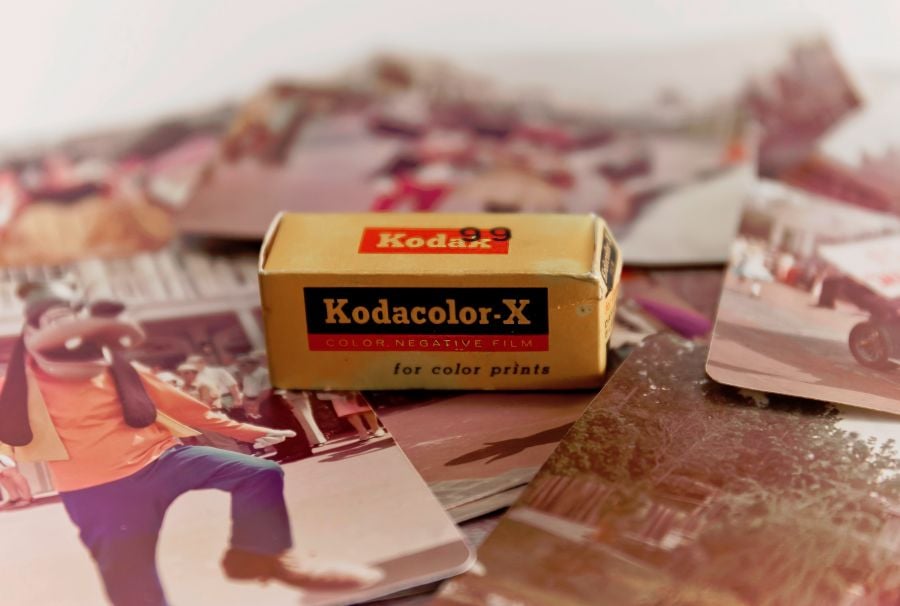
An original Kodacolor-X film roll and photos taken on Kodak Kodacolor film in the 1970s.
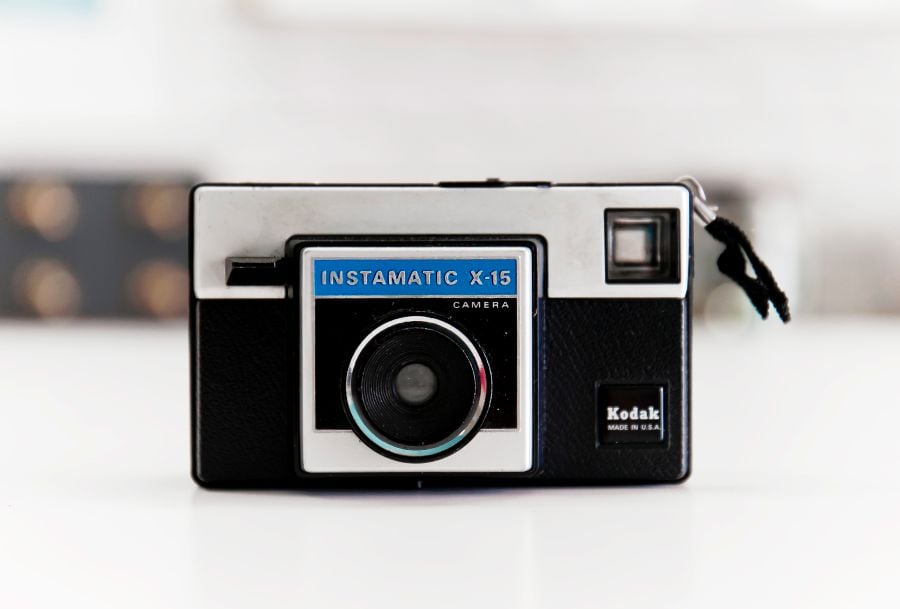
A Kodak Instamatic X-15 camera for color photos. One of the earliest mass-produced color photo cameras.
Magnetic Scrapbook Albums
Another new technology came to scrapbooks themselves in the 1970s: magnetic albums. Despite the name, magnetic albums aren't actually magnetic in any way, and did not contain magnets or any magnetic properties. These albums featured sticky cardboard pages that were covered with a plastic sheet that could be peeled back to insert a photo or memorabilia on the page. Then, the plastic would be smoothed back down over the page, sealing the photo and memorabilia into the album. We can safely assume that the name "magnetic" came from the fact that pictures and other items would stay in place and not fall out.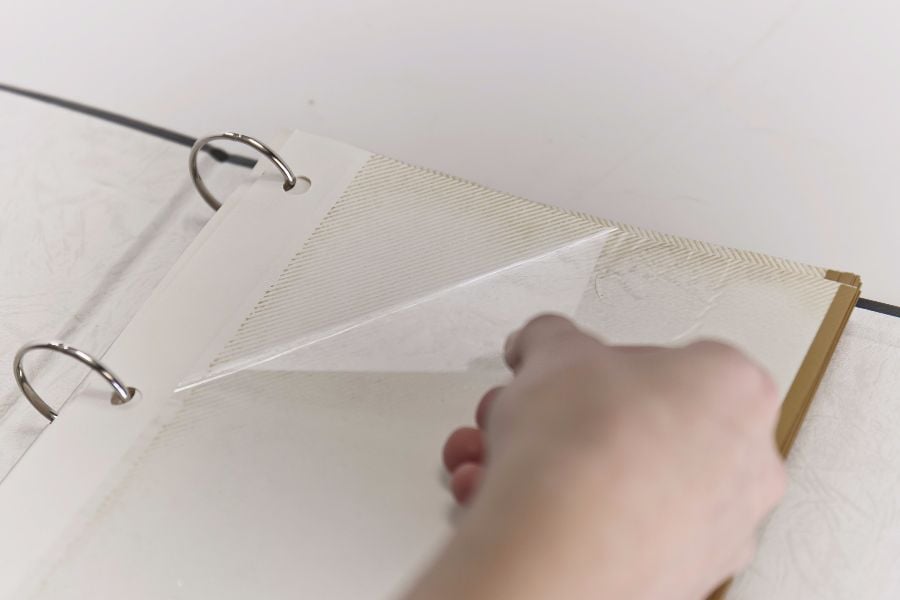
Magnetic photo album showing the clear cling film that lies on top of photos and memorabilia to help keep them in place.
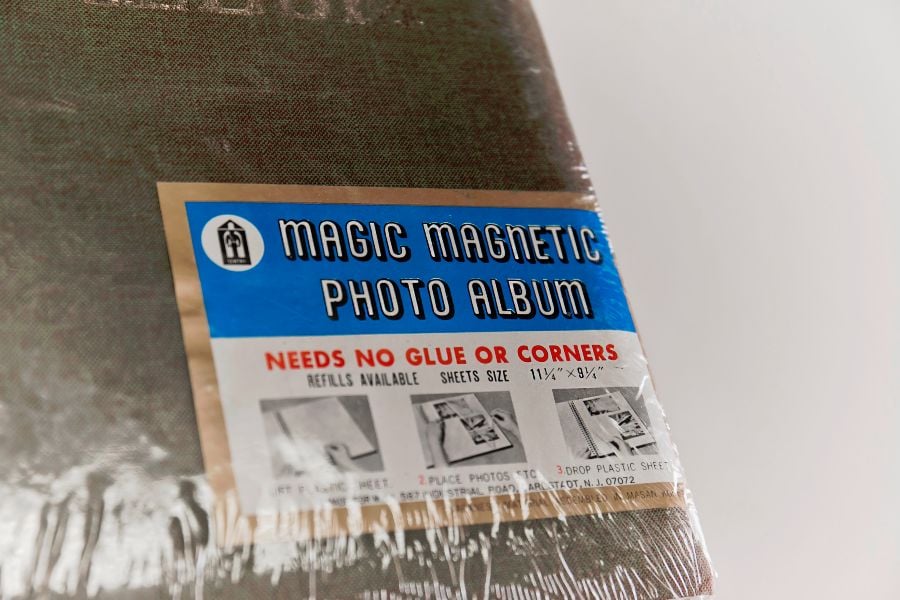
A magnetic photo album in its original packaging.
Magnetic albums became popular as a convenient and quick way to store photos and memorabilia without having to work with glue or fuss with photo corners. Over time, however, the materials in magnetic albums were very destructive to photos. The cardboard gave off peroxides which caused papers and photos to yellow. The adhesive used in the albums was acidic and permanently destroyed photos, newspaper clippings, and other paper items. And the plastic sheet that laid down over each page was also acidic. These magnetic albums from the 1970s were, sadly, a death trap for historical documents and photos. Much of the later obsession with photo-safe materials, especially in the early days of the modern scrapbooking era, came as a reaction to the destruction of photos and documents that scrapbookers had witnessed from the use of the magnetic album.
Note: You can learn all about photo and paper preservation in our comprehensive guide.
The Birth of Modern Scrapbooking
If you had to pinpoint exactly where today's form of scrapbooking originated, the birth of modern scrapbooking is generally accepted to have occurred in 1980 at a genealogy event called The World Conference on Records. Marielen Christensen was invited to the Church of Jesus Christ of Latter-Day Saints event in Salt Lake City to display her 3-ring binder albums (50 of them!) full of decorated scrapbook pages that she had begun creating a few years earlier. Christensen used archival-safe materials and put her scrapbook pages in clear page protectors - something done for the first time. She also introduced a unique photo and record-keeping system. The concept resonated with Mormon church members, whose faith values family and genealogy research.
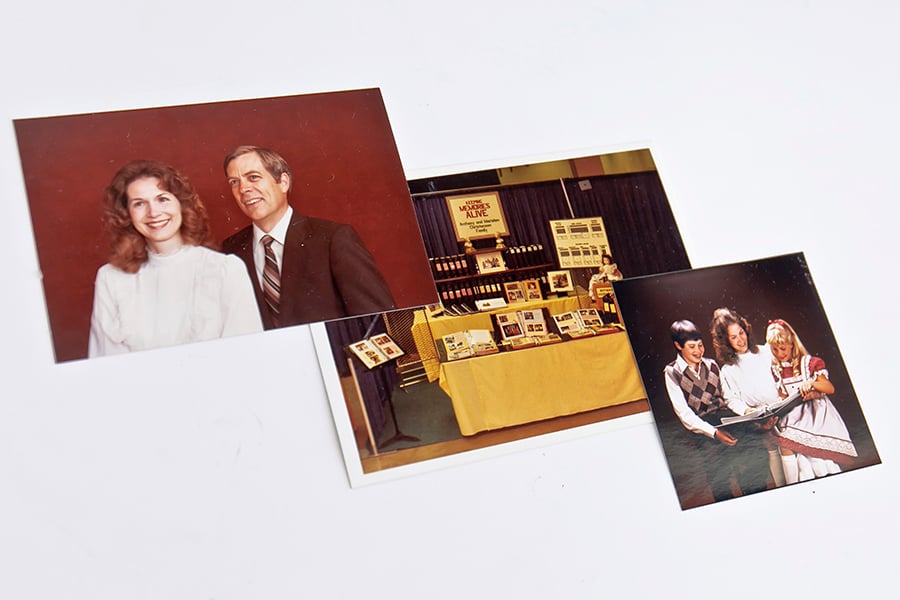
From left to right: Photograph of Marielen Christensen and her husband AJ in 1979. The Keeping Memories Alive booth at the World Conference of Records. Marielen looking at a scrapbook with two of her children.
In 1981, Christensen opened the first store devoted to scrapbooking called Keeping Memories Alive. The store, located in Spanish Fork, Utah, became a destination for scrapbookers. Scrapbookers from around the country would travel to Utah to visit the Keeping Memories Alive store. Soon after, the Christensens also started a mail-order catalog for those who could not make the trip.
Note: Jill Davis, Scrapbook.com Founder, was inspired by Marielen's ideas and innovations. She made several trips to the Keeping Memories Alive store in Spanish Fork, Utah, in the early 1980s to purchase scrapbooking supplies.
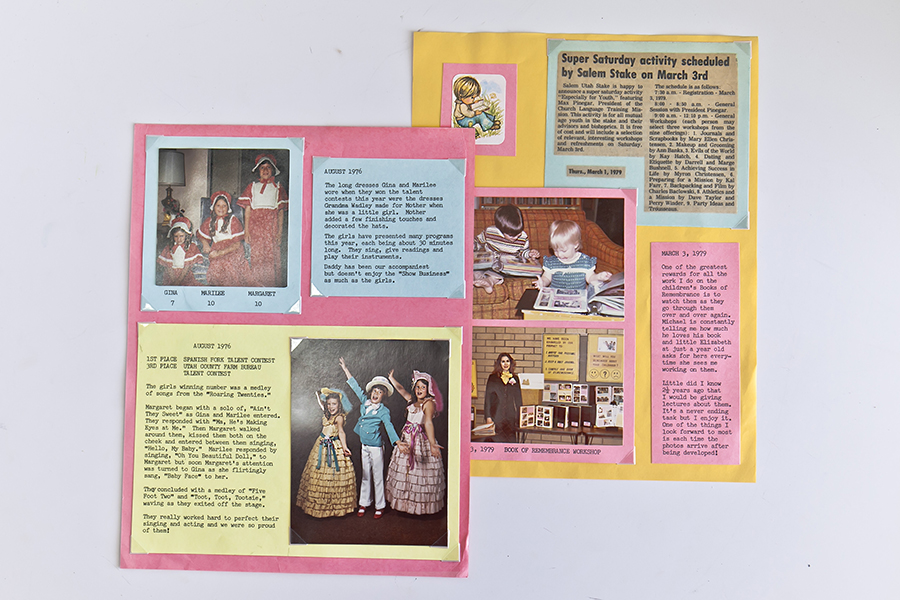
Two of Marielen Christensen's original scrapbook pages. One from 1976 and the other from 1979.
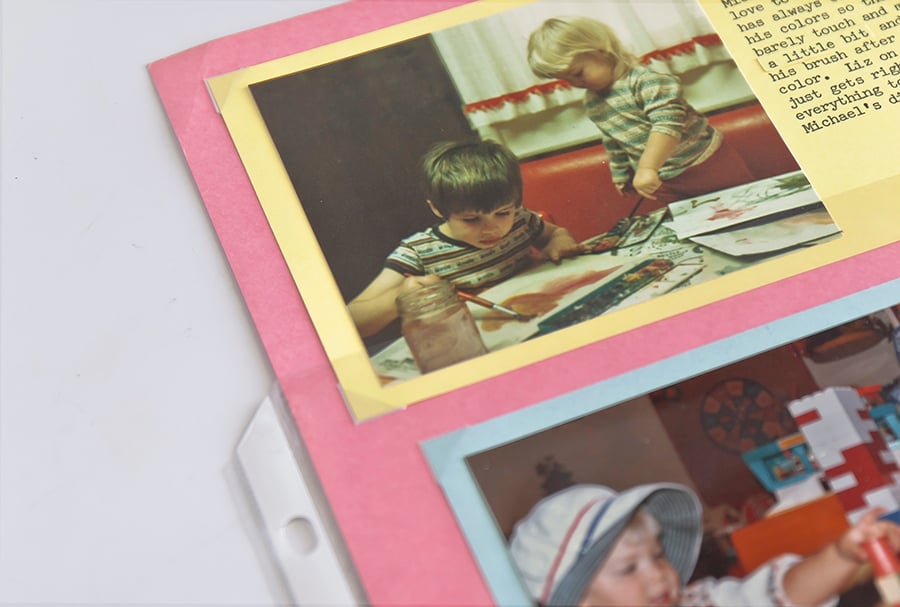
A close-up of one of Christensen's early scrapbook pages in a clear protective page protector. Christensen was the first to utilize page protectors to protect and store her scrapbook pages. This was a key advancement in modern scrapbooking.
Christensen's original scrapbook pages were, by necessity, on 8 ½" x 11" letter sized paper. She stored the pages in clear plastic sheet protectors inside three ring binders. This innovative use of page protectors was a key shift in scrapbooking for many reasons. Clear page protectors helped protect photos and pages from damage, but they also paved the way for a new era of page-by-page creation. The original, Keeping Memories Alive scrapbooking papers were also 8 1/2" x 11", and many of them were adapted from stationery designs.
By the late 1990s, however, the standard scrapbook page size was shifting to a larger 12" x 12" square page that better accommodated 4" x 6" photos. Albums began to be available in a variety of types of bindings: strap hinge, post, and ring, to suit a growing community's growing needs. Some strap hinge albums still had paper pages similar to those of the early scrapbooks, but albums full of sheet protectors (to allow each page to have a different background paper) were increasingly becoming the scrapbook format of choice.
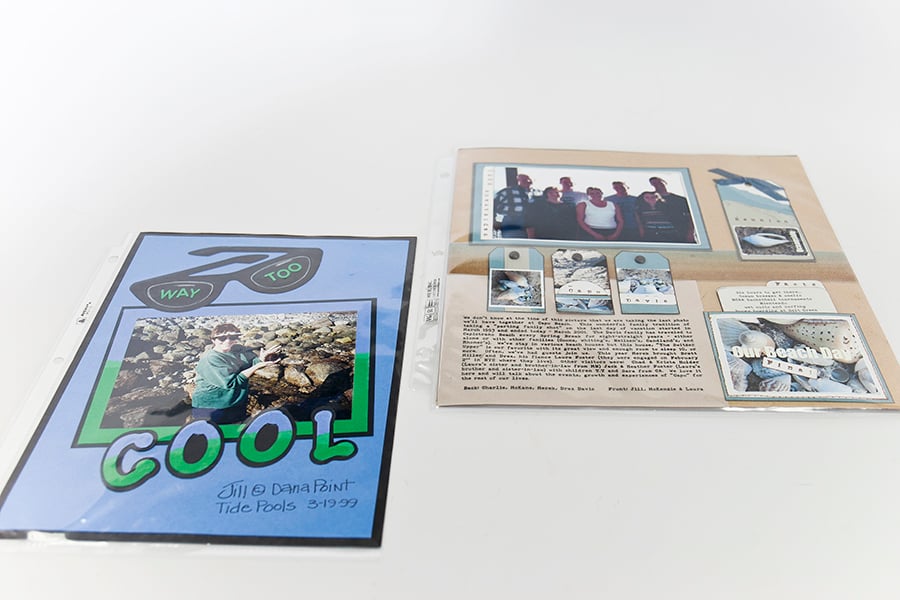
An 8 1/2" x 11" page on the left (from 1999) before the transition and a 12" x 12" page on the right (from 2002) after the transition to larger pages. Both pages were created by Jill Davis - Scrapbook.com Founder.
Digital Cameras
Around the time that color film was just becoming the standard for personal photography, the first digital camera had already been invented. Kodak engineer, Steve Sasson, developed the first digital camera, a prototype, in 1975. However, it would be a few more decades before digital photography became common (and affordable) consumer technology. And when it did, its takeover of the photography world was rapid.
The first consumer digital camera was launched to the photography market in 1990. By 2006, Nikon and Canon had stopped development on new film cameras and had shifted all new camera production to entirely digital models. It had been barely over 15 years since the first digital camera was sold, and now film was going the way of the horse and buggy.
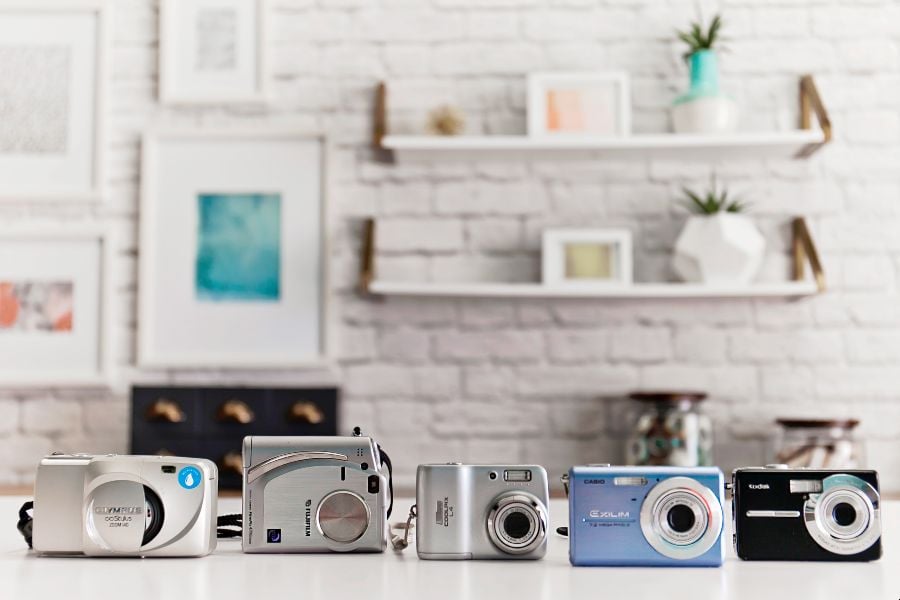
Different types and models of Digital Cameras from the mid-1990s to the mid-2000s.
Digital photography eliminated a major barrier to taking pictures: cost.
With film, each click of the shutter had a price - first to purchase the film itself, and then to develop it. Although the price of film photography had decreased significantly over the course of the 20th century, as the technology aged and improved, costs could still easily run at least $10 for each roll used.
By contrast, a click of the digital shutter to take a photograph was free. Cost per image only became a factor when the photographer chose to print out an image. With this new freedom, photographers began clicking away, taking huge volumes of photos.
The Advent of Local Scrapbook Stores
By the late 1990s, several local scrapbook stores had popped up around the country. These stores provided a large selection of scrapbook albums, papers, and other products. The Local Scrapbook Store phenomenon continued into the 2000s. These early local scrapbook stores were a response to the booming interest in scrapbooking, but they were also instrumental in helping spread awareness of scrapbooking and enthusiasm for it.
Learning to Scrapbook
The 1990s also brought the inception of several scrapbooking magazines. Creating Keepsakes, Memory Makers and others saw meteoric growth during the second half of the 1990s and early 2000s. These magazines taught people across the globe how to scrapbook and they were also instrumental in spreading awareness and interest in the booming hobby. By the late 1990s scrapbooking magazines could be found on magazine stands of chain bookstores and retail stores across the United States.
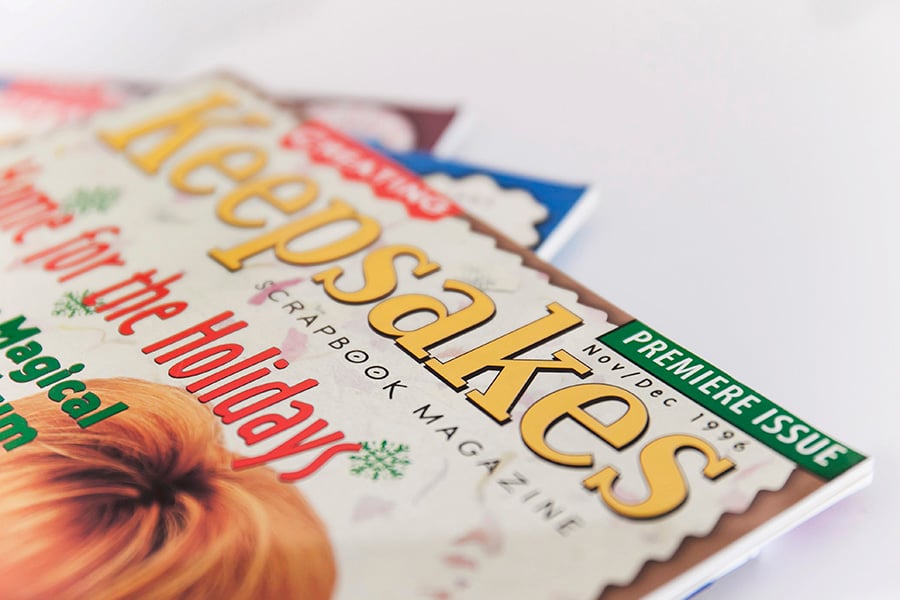
The first issue of Creating Keepsakes magazine published November 1996.
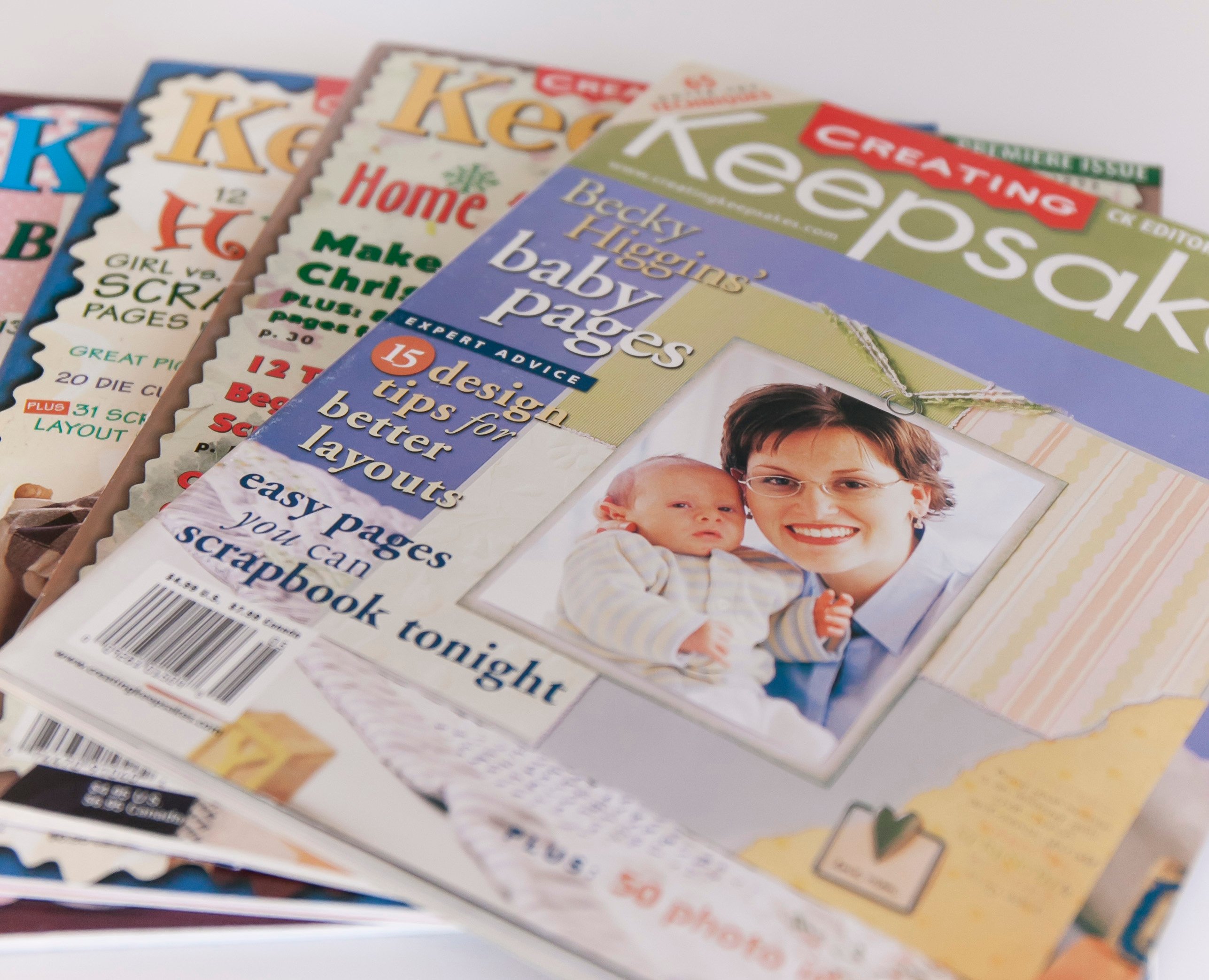
Several early issues of Creating Keepsakes magazine from the mid-1990s.
During the 1990s scrapbookers also began gathering at events called "crops" where they could share supplies and teach each other new techniques. These social scrapbooking gatherings, which still happen today, are similar to quilting gatherings called quilting bee's that were popularized early in the 20th century.
Creative Memories, Close to my Heart, and other home-based retailers of scrapbooking supplies were also very important to the growth of the hobby. Independent representatives for these companies held parties in their homes to teach friends and family members how to scrapbook, and sell the supplies needed in order to do so. Creative Memories, which was founded in 1987, became the largest home-based retailer and saw meteoric growth through the 1990s and early 2000s. Creative Memories representatives were both instrumental to the growth of the hobby and benefited from the rise in popularity at the same time. In 2004, at their peak, Creative Memories representatives drove over $400 million dollars in retail sales.
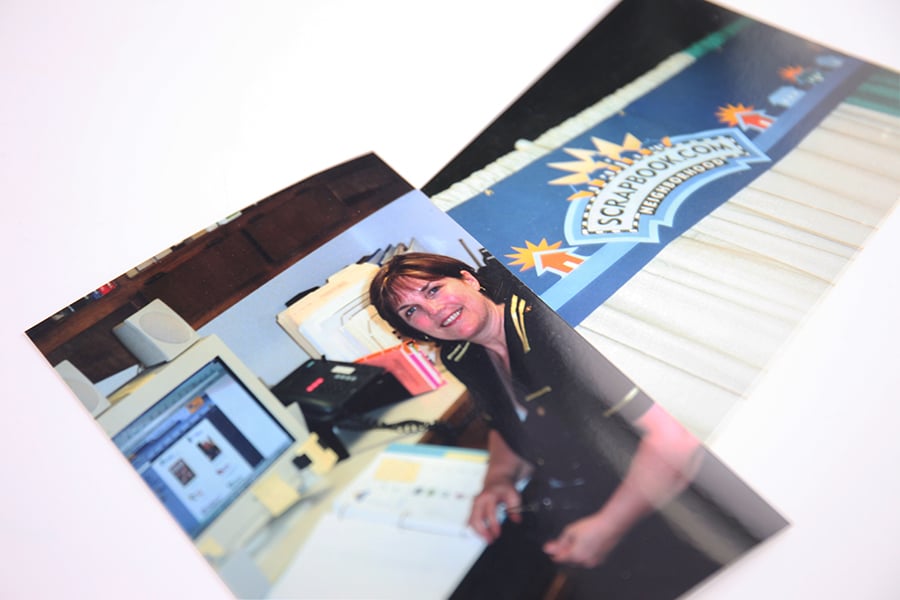
A photograph of Jill Davis on the day Scrapbook.com was launched in 1999.
Jill Davis, an artist and calligrapher, was one of the earliest pioneers in the modern scrapbooking movement. She had been inspired by Marielen Christensen in the early 1980s and started creating her own scrapbooks and developing her own unique scrapbooking techniques and ideas soon after. By the late 1990s, she was teaching sold-out scrapbook classes in Arizona. Davis wanted to share her ideas and love for scrapbooking to a larger audience. In 2000, she and her husband Charlie launched Scrapbook.com, a place where Jill, and others, could teach the world how to scrapbook.
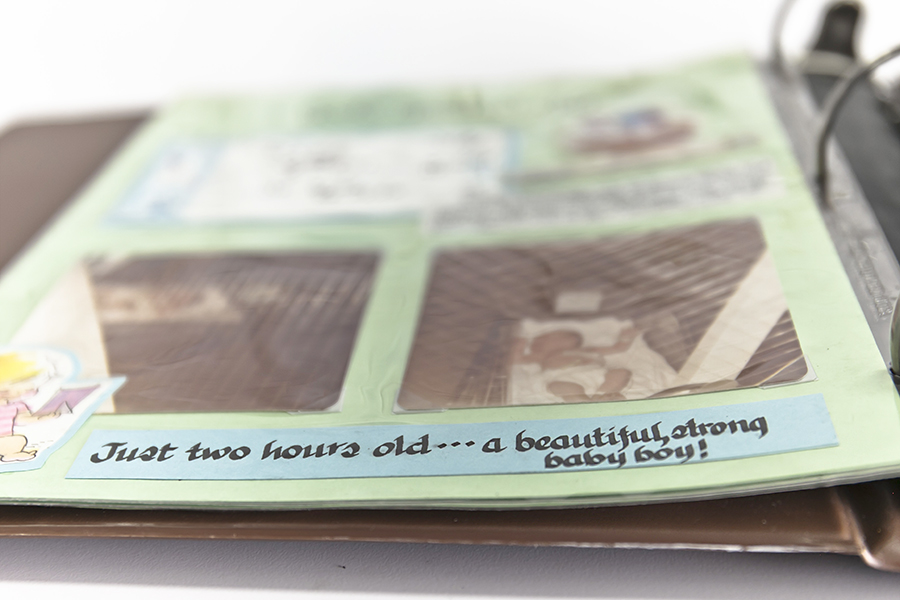
One of Jill Davis' earliest scrapbooks. Jill's early style was inspired by Marielen's scrapbooks and Jill also used clear page protectors as well, based on Christensen's system.
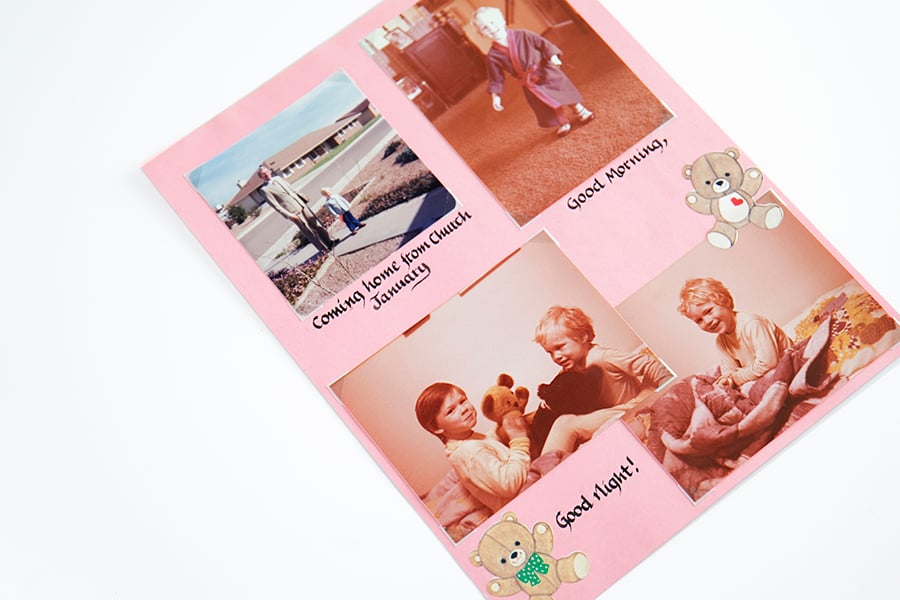
An 8 1/2" x 11" scrapbook page created in the early 1980s. Jill used calligraphy writing style for her captions and journaling on her pages.
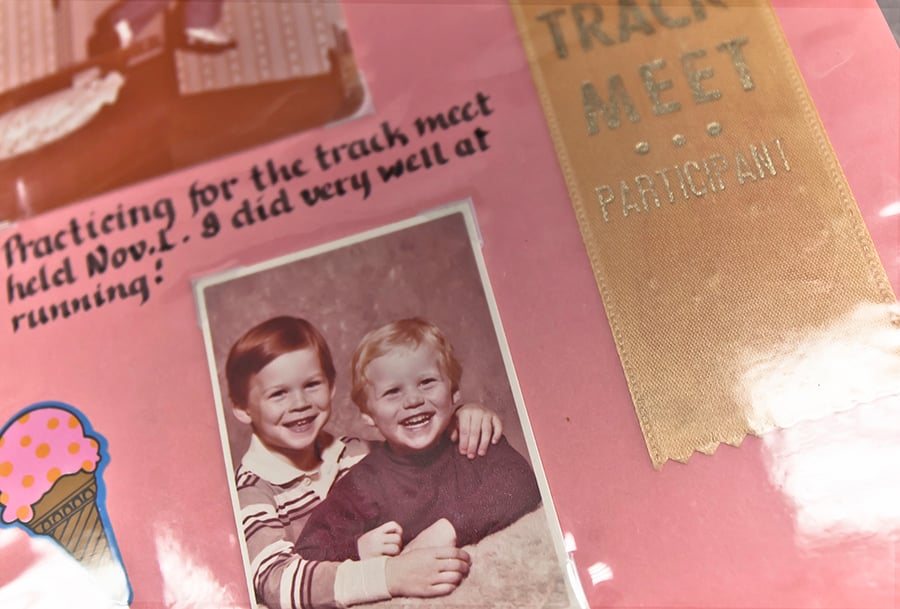
One of Jill's early scrapbooks. This photo showcases current Scrapbook.com CEO, Drex Davis, on the left (Age 5) and current Scrapbook.com President, McKane Davis (Age 3).
Later, Scrapbook.com created an online project gallery where people across the globe could take photos or scans of their creations and upload them in one place online to share. Soon, scrapbookers everywhere were teaching and inspiring each other in a way that seemed unimaginable just a few years earlier.
Note: Today, Scrapbook.com hosts the largest gallery of scrapbook projects in the world with over 2.5 Million scrapbook layouts, handmade cards, and other papercrafting projects. Scrapbook.com also offers free high-quality video classes continuing Jill's original vision.
Note: During the early 2000s several additional sites like Two Peas in a Bucket, Scrapjazz, DMarie, and a variety of other sites were also instrumental in connecting scrapbookers across the globe and helping to spread knowledge about the craft.
Smartphone Cameras
Now, our camera is omnipresent. It's ready to use at a moment's notice. We can anddo use photography now to record the everyday minutiae of our lives...
The advent of digital photography was a revolution in itself for scrapbooking, but when digital cameras were added to smartphones, it caused a second revolution.
The first mobile camera phone was introduced in 2000, although it wasn't until about 5 years later that camera phones gained enough traction, and quality, to be truly useful. With the development of quality smartphone cameras, personal photography was transformed again.
Like the Brownie had 100 years earlier, digital photography and the camera phone changed - not just how many photos we could take, but the type of photos that people took. The ubiquitous presence of our smartphones in our pockets or purses, at an arm's reach, meant that taking photos no longer required planning ahead or remembering to get out the camera and take it with us. Now, our camera is omnipresent. It's ready to use at a moment's notice. We can and do use photography now to record the everyday minutiae of our lives, not just the big events. Now, we take pictures of our food, our pets, or the weather on a regular basis.
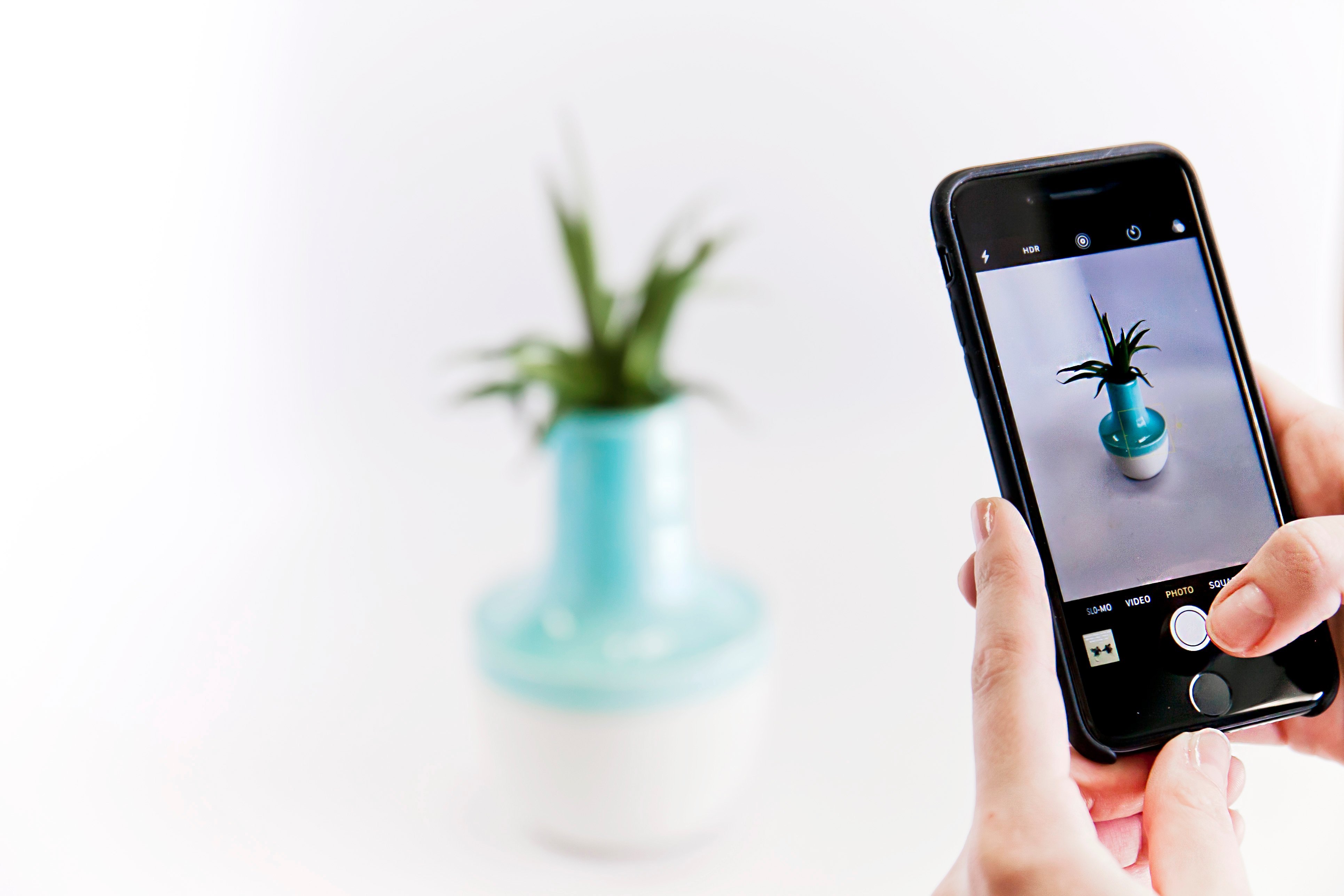
Between the removal of cost barriers, with digital photography, and the constant use of smartphone cameras, scrapbookers in the 21st century began to be flooded with photos. Having enough photos is no longer a problem. Many were now taking the volume of photos in a month that they had previously taken in a year with film.
Pocket-Page Scrapbooking
Then, in January 2008, Creating Keepsakes Magazine launched a kit called Project 365 as part of their "kit of the month" program. Creating Keepsakes Creative Editor Becky Higgins designed the kit as a "photo a day" album, and it featured page protectors with individual pockets to insert photos and decorative cards. Few could imagine, at the time, that this simple kit would be the genesis of another major shift for scrapbooking.
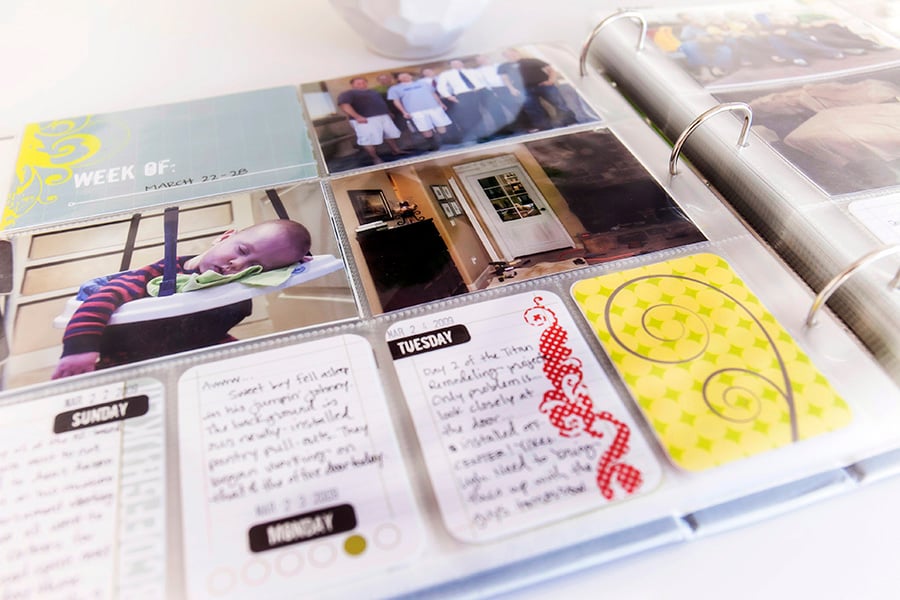
One of Becky Higgins' original Project 365 albums showcasing pocket-page scrapbooking.
Pocket-page protectors had been available to scrapbookers for quite some time, but it wasn't until the Project 365 kit that pocket-page scrapbooking received wide-spread adoption and captured the imagination of scrapbookers around the world. Pocket-page scrapbooking challenged the very definition of a scrapbook as photos on a blank page and scrapbooking expanded to include putting things in pockets.
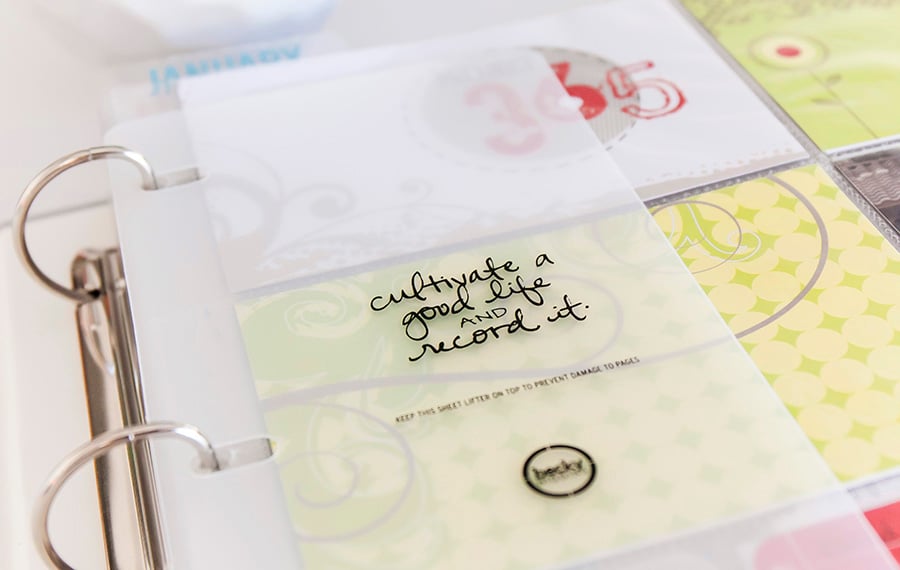
In late 2009, Becky Higgins left Creating Keepsakes and launched her own company to introduce the Project Life system. Project Life followed in the footsteps of Project 365 by offering kits of decorative cards that could be placed alongside photos in pocket-style plastic protectors. For scrapbookers, Project Life helped answer the question of what to do with all of the new "everyday life" photos they were accumulating. It also simplified the scrapbooking process and lowered the barrier to entry for new scrapbookers. Project Life appealed to those who may have felt overwhelmed by scrapbooking and also became an entry point for people who had never scrapbooked before.
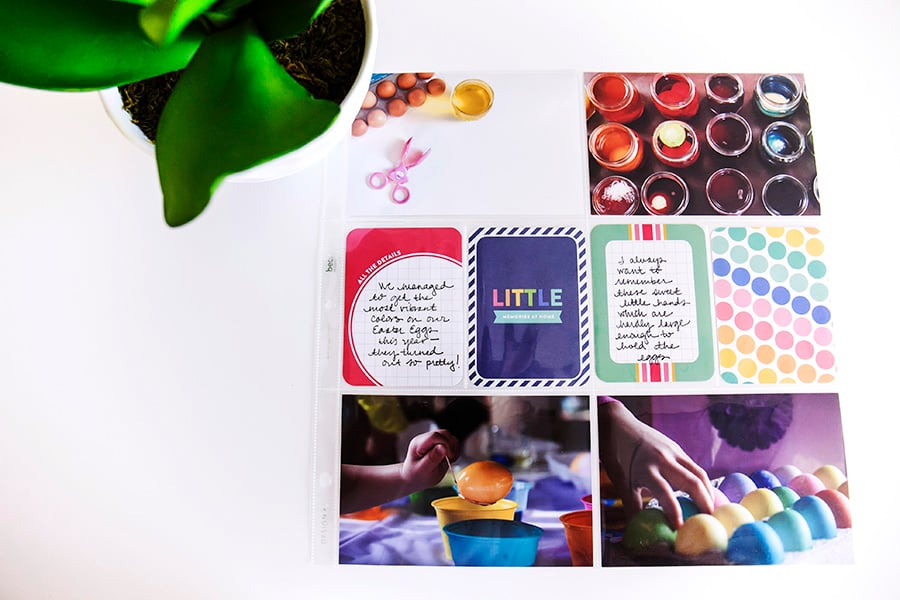
A more recent Project Life pocket-style page created by a Project Life customer.
Just recently, Scrapbook.com introduced a spectacular product that combines pocket page scrapbooking with the growing desire to preserve memories. Looking to answer the beginning scrapbooker conundrum of "how and where do I start?", Scrapbook.com launched Simple Scrapbooks. No artistic ability or experience is required to create a totally unique, complete, one-of-a-kind scrapbook.
Each Simple Scrapbooks Kit comes with all the supplies you need bundled together, so you never have to guess what supplies you need. You don't even need tape, scissors, or glue - just your favorite 4" x 6" and 3" x 4" photographs, a few great memories, and you're ready to go! The kit comes with a perfect 6" x 8" album, a large variety of themed cards, lined journal cards, page protector sleeves, and a pen for jotting down your memories.
Note: The rise of pocket scrapbooking did not replace 12" x 12" scrapbook pages. Pocket cards now reside side by side with more traditional 12" x 12" pages as staples in many companies' scrapbook lines – and in scrapbookers' supply cabinets and albums. Many scrapbookers utilize both types of pages, sometimes even in the same album, to meet their needs for a particular project.
Note: If you are interested in pocket-page scrapbooking you can take our free video class and learn more here.
Social Media and Photography
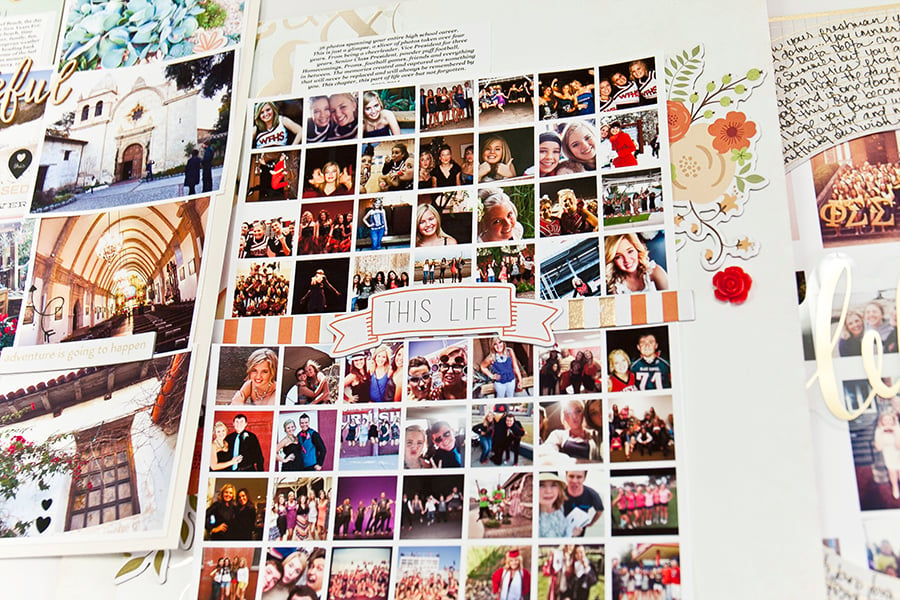
Recent layouts from renowned scrapbooker Dedra Long showcasing square Instagram style photos.
As the camera phone has come to dominate personal photography, photography trends from social media are finding their way into scrapbooks. The most prominent has been the influence of Instagram. Where once photography (and thus by extension, the scrapbook) was prized for its realism, now, scrapbooks are being filled with photos that have been stylized with filters that create artistic effects. Instagram, which initially only allowed square photos, also led to an influx of scrapbooking products created for the square photo.
Modern Planners, Journals and Recordkeeping
Proving that old ideas can be new again, the newest form of scrapbooking has roots in one of the oldest. Many scrapbookers are reinventing traditional weekly day planners as embellished daily journals and personal records. These planners are reminiscent of the centuries-old tradition of the commonplace book – an assemblage of notes and information from a person's life. In the modern incarnation, planner enthusiasts are adding photos, stamps, stickers, and other embellishments to their handwritten notes to create a result that is both decorative and also a historic document.
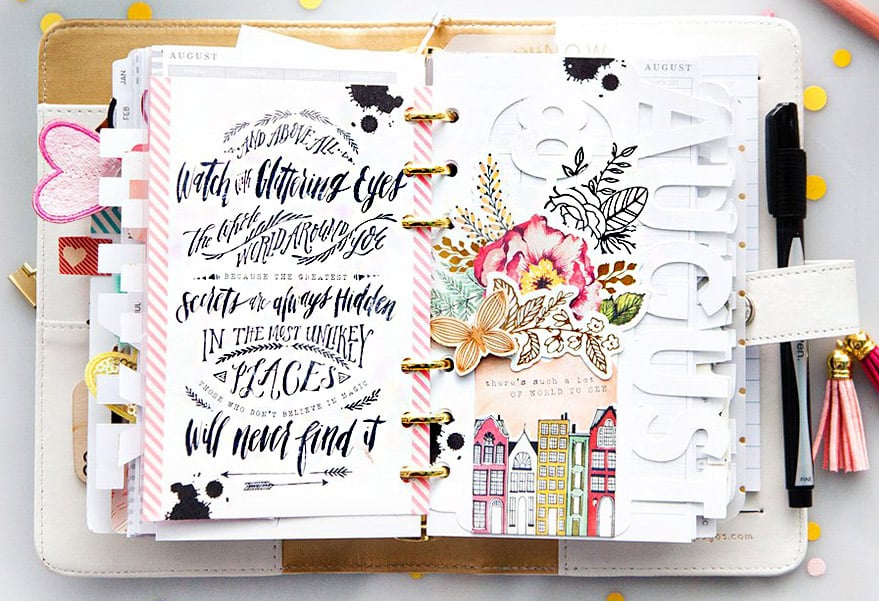
A modern planner used for calendaring, record-keeping and journaling.
Bible journaling has also exploded in popularity in recent years. In fact, like Granger's old Kitto Bible, modern Journal Bibles are created with blank space in the margins for illustrations, stickers and journaling. Many scrapbookers will record their thoughts in the margin of their bible and personalize them. These bibles act as inspiring faith-journals and are given as keepsakes for future generations.
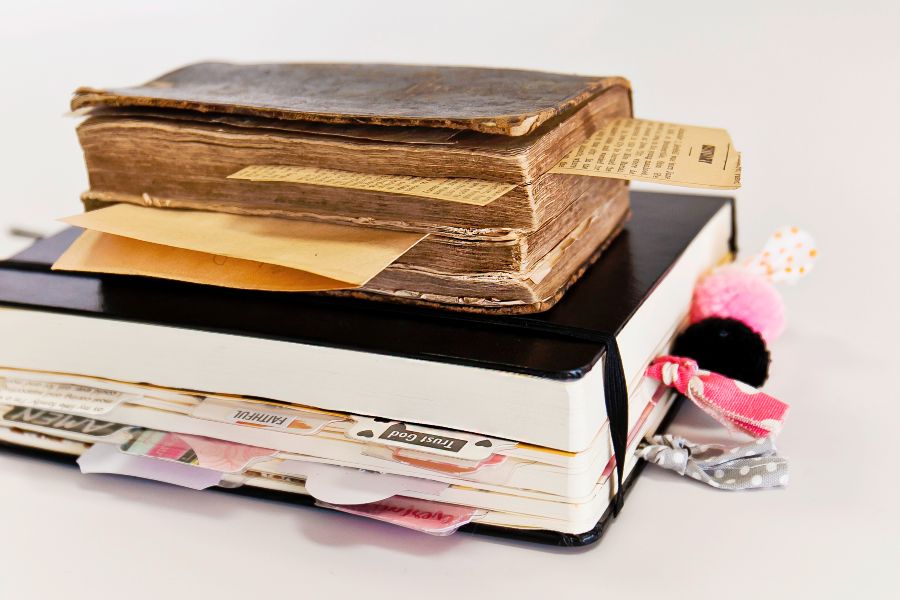
An 1800s bible that was used for family record keeping (top) contrasted with a modern bible used for journaling and documentation today (bottom).
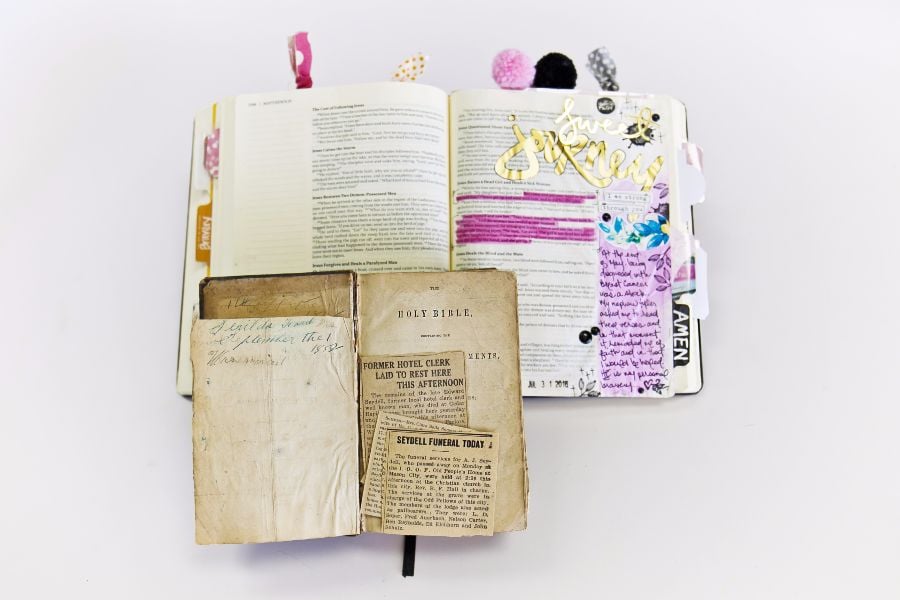
An antique bible used for family record-keeping and documentation compared to a modern day Bible with bible journaling
Note: If you would like to learn more about bible journaling, you can take our free video class: Art Journaling in Your Bible.
Today's Scrapbooks
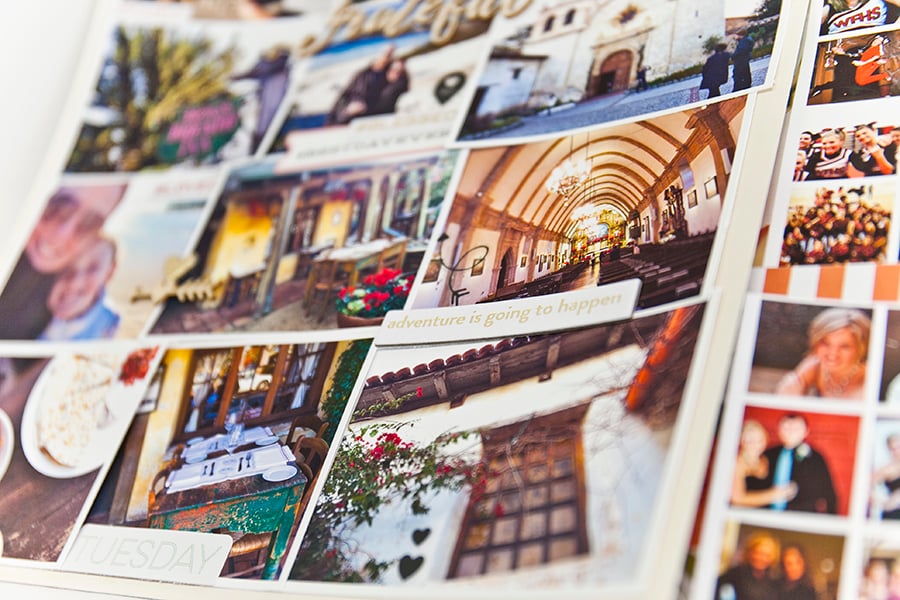
Modern scrapbook layout by Dedra Long.
Today's modern scrapbook layouts combine handwritten entries (like those in commonplace books) with doodles (like those in grangerized ones). They contain professional portraits (like those of the 1800s) with casual photographs (like those popularized in the early 1900s). The modern-day scrapbook is the culmination of its history.
While the technology and techniques may have changed over the centuries, one thing has remained the same – the human urge to record our history and tell our stories. Whether you call it a commonplace book, a grangerized book, a photo album or a scrapbook, one thing is for certain - scrapbooking leaves a legacy for future generations through beautiful, meaningful, handmade self-expression.
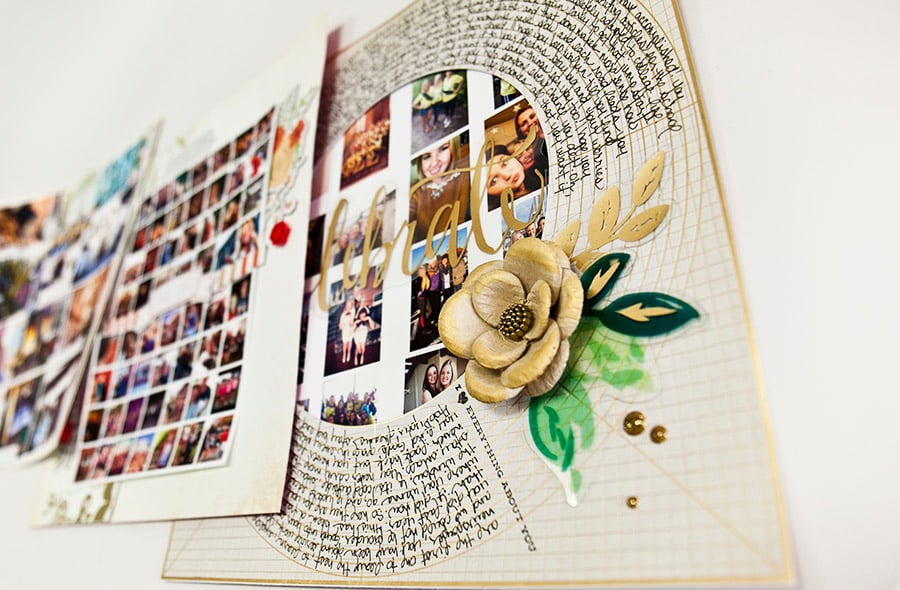
A modern scrapbook page created by Dedra Long. This page combines several elements including journaling, titles, decorative 3-D memorabilia and color photos.
Additional Resources
Protecting Your Memorabilia so it can Stand the Test of Time
Protecting Your Photos and Documents From Being Destroyed
Choosing a Scrapbook
A Brief Chronology of Scrapbooks
The Staying Power of Scrapbooks
We would like to give a special thanks to Nancy Nally of Scrapbook Update for her help with this project. Her expertise and contributions were integral to the creation of this resource.
Https Www.scrapbook.com Signup V 04d77f48ab319512672343f7eee866be
Source: https://www.scrapbook.com/articles/history-of-scrapbooking
Belum ada Komentar untuk "Https Www.scrapbook.com Signup V 04d77f48ab319512672343f7eee866be"
Posting Komentar